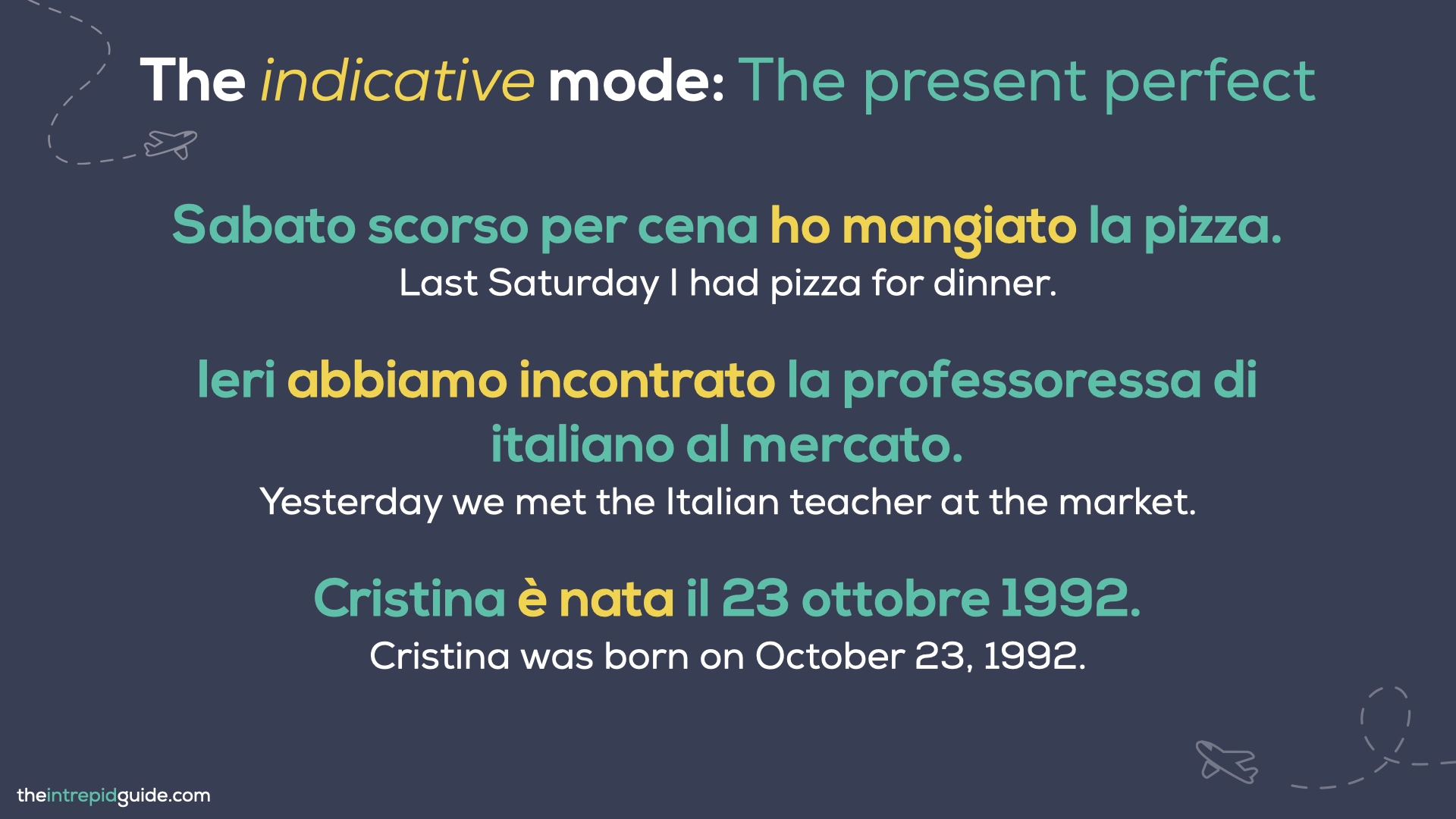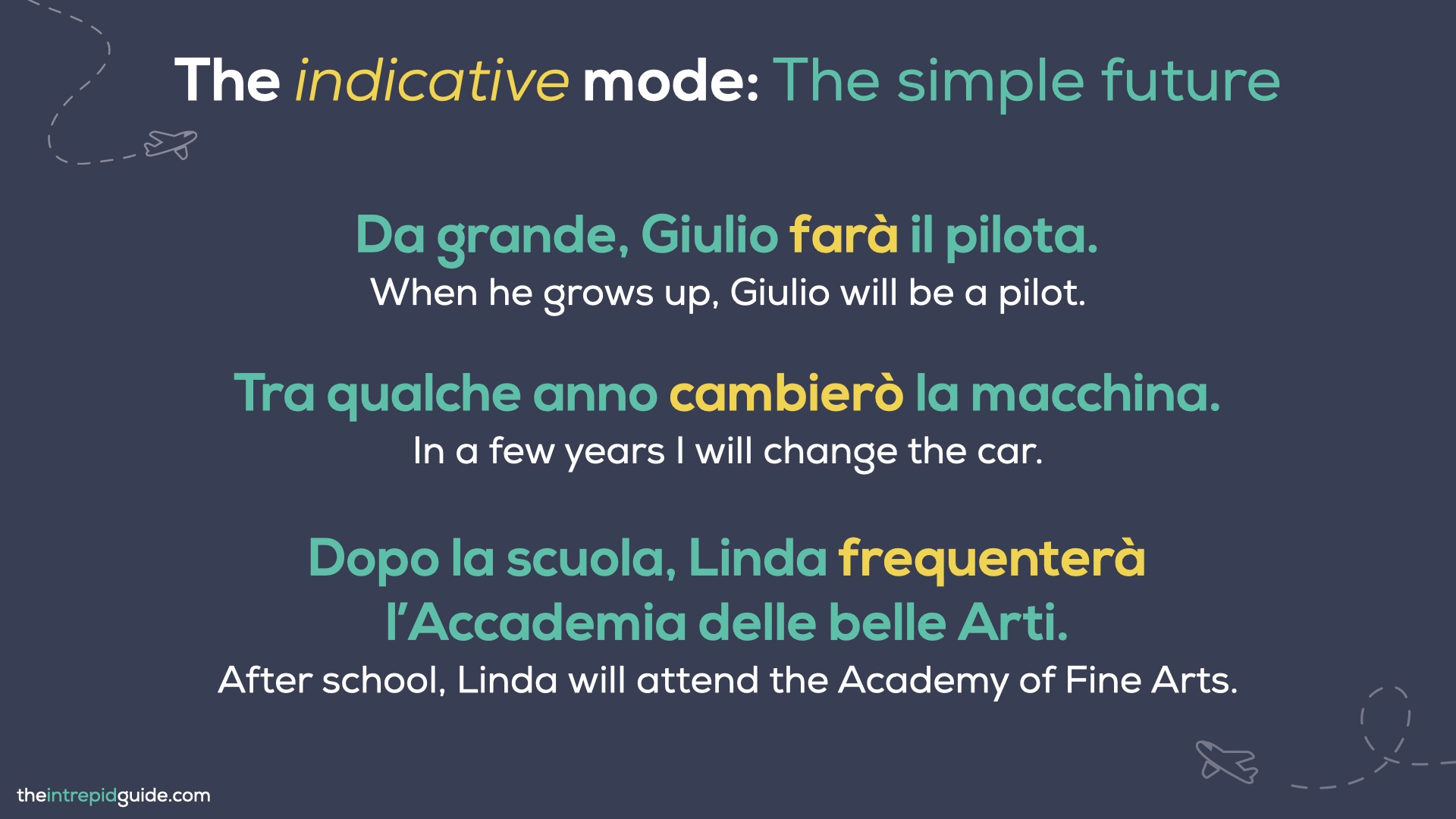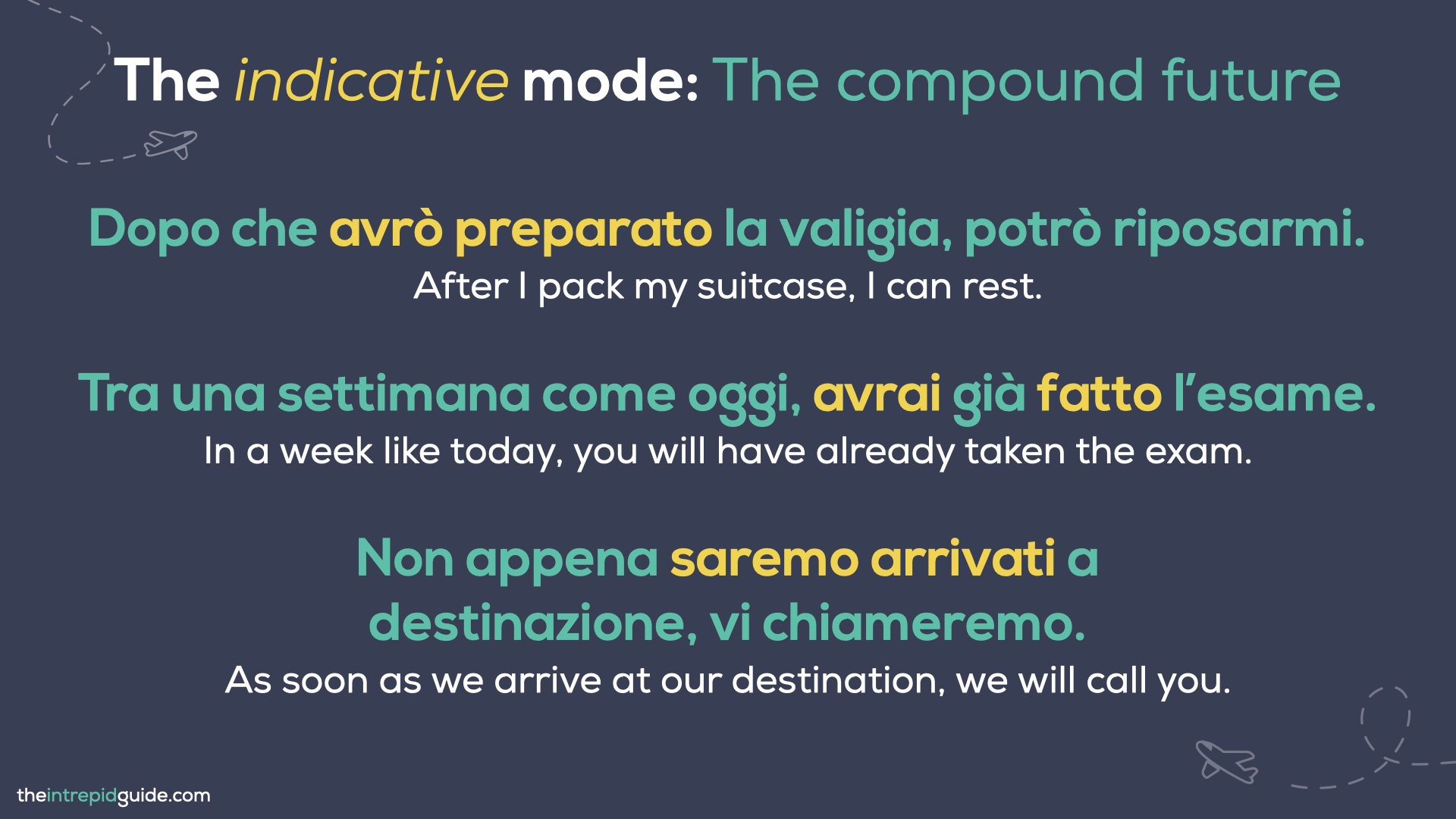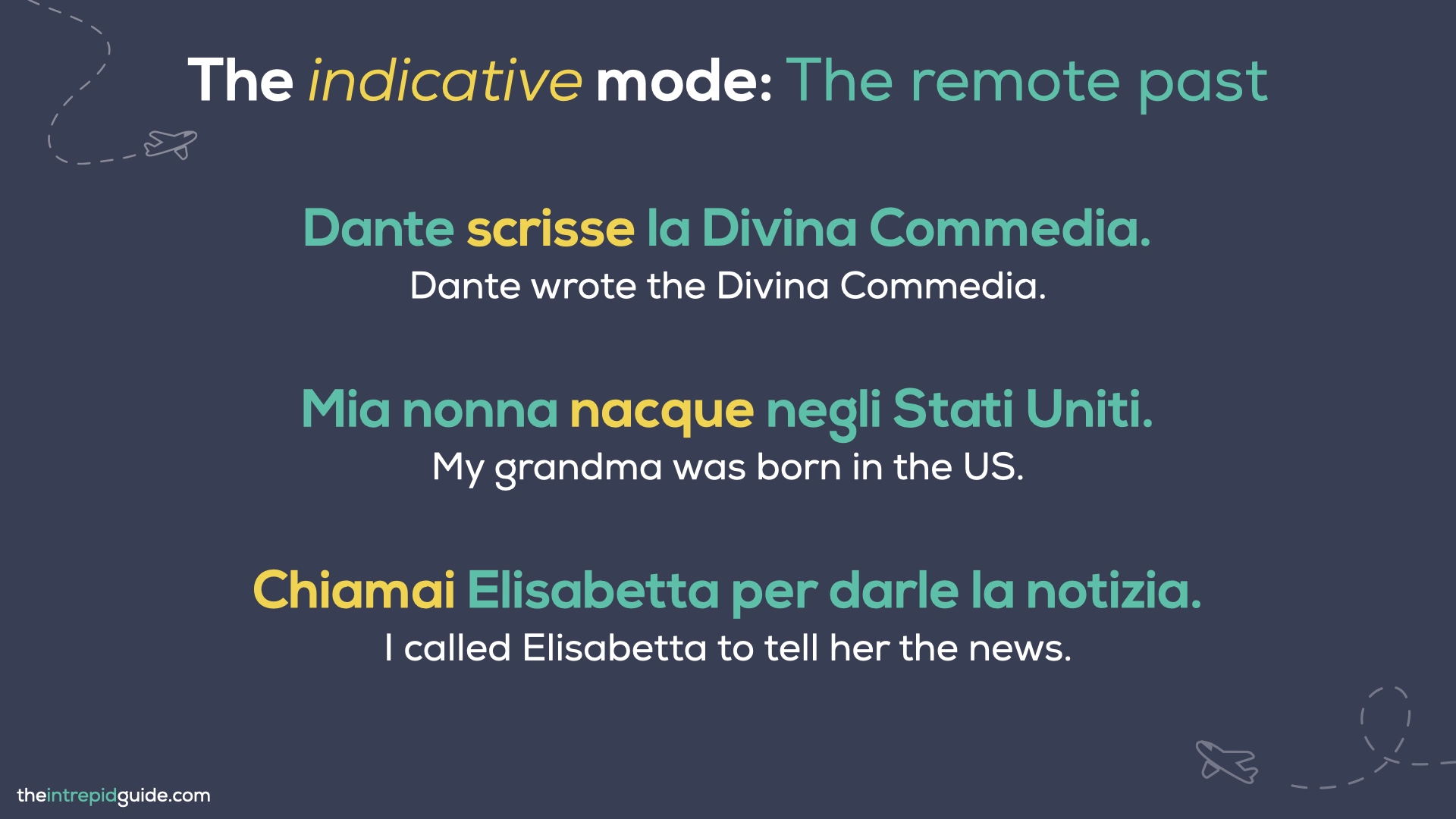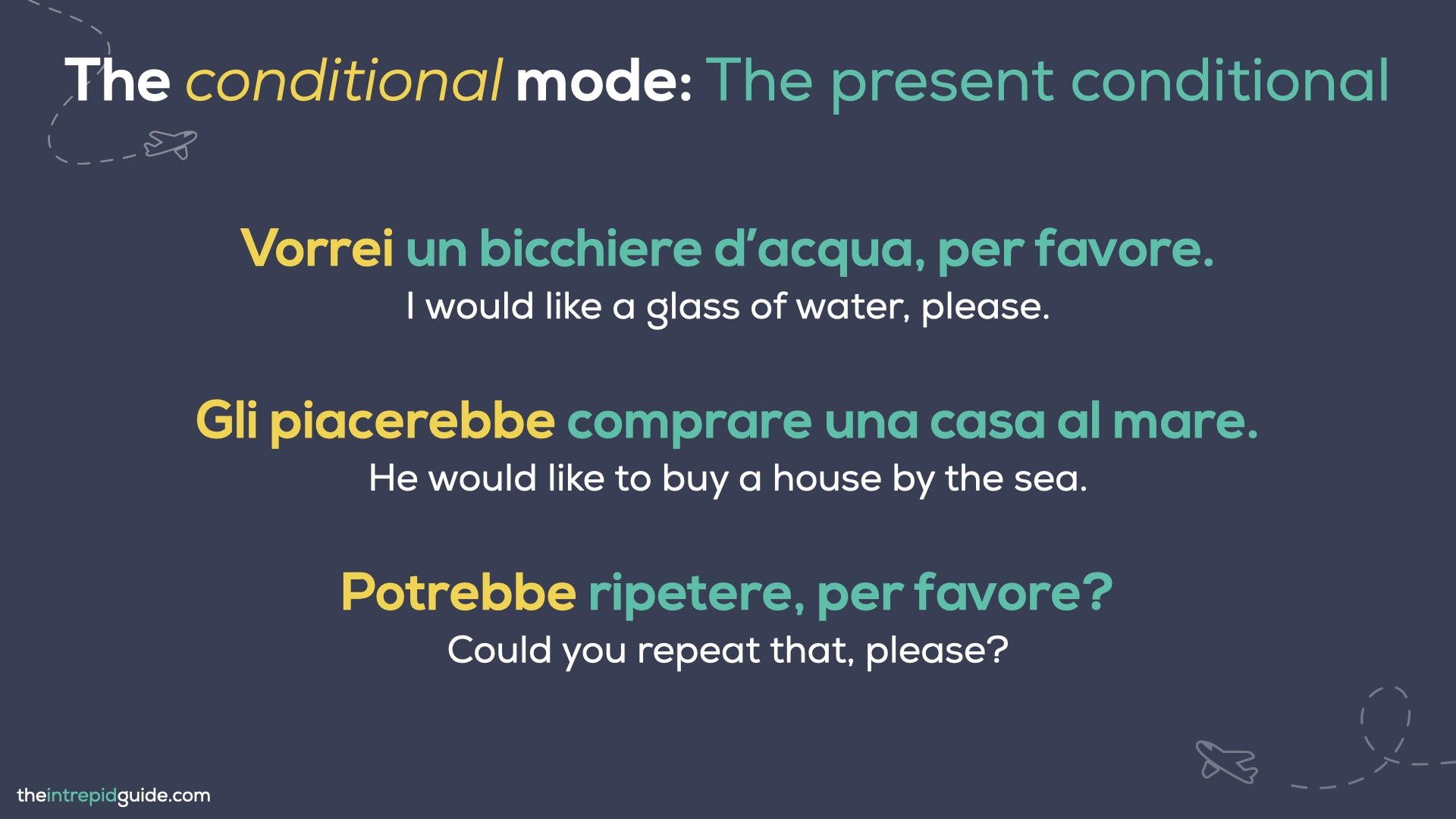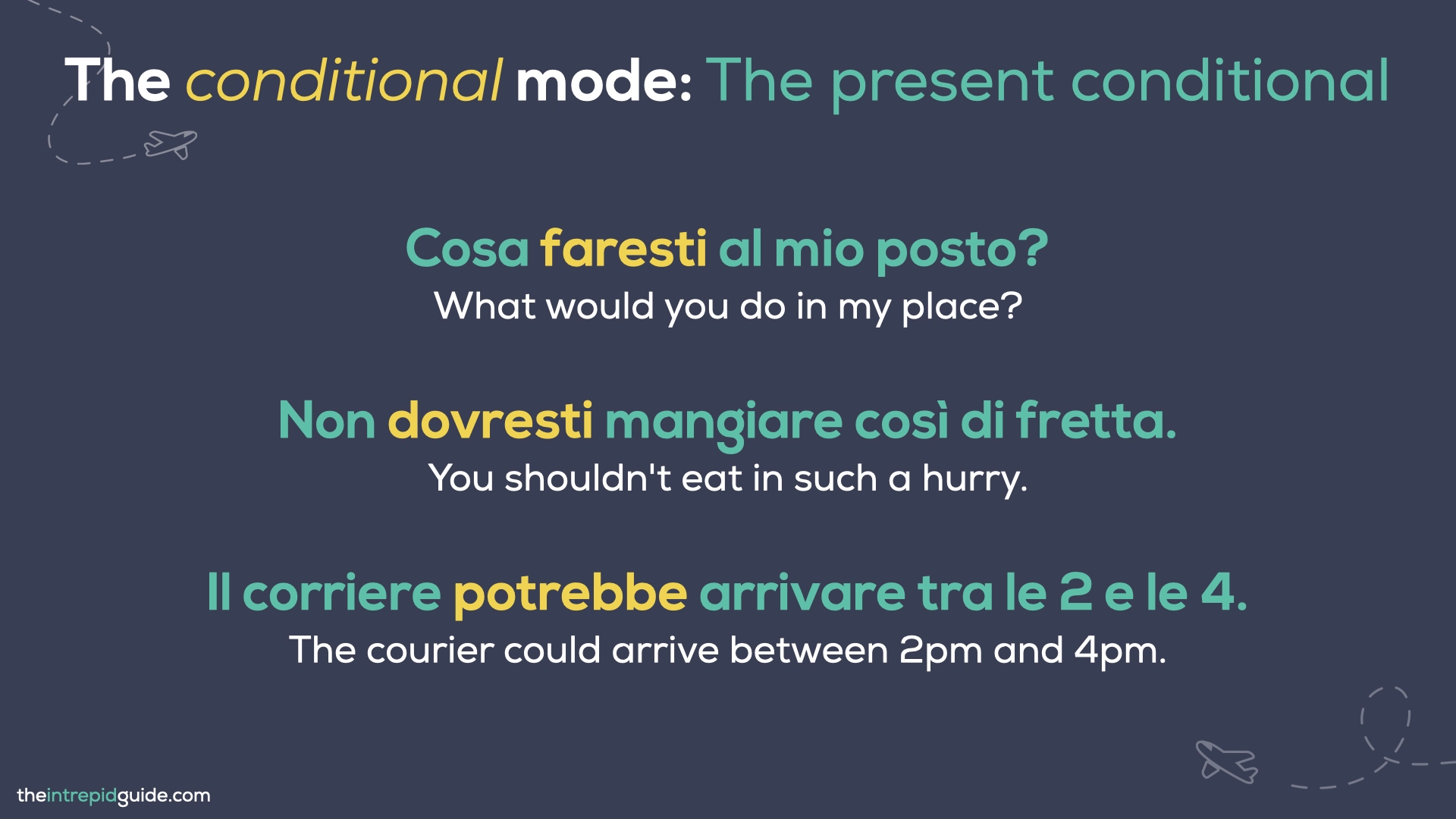Do you tense up when you speak Italian? Does deciding which tense to use stress you out? Do you use the passato prossimo or the imperfetto? And when do you use the dreaded congiuntivo? It’s enough to make you say mamma mia!.
If you want a future where you speak Italian like a native, you need to learn Italian tenses! From past to present and beyond. The problem is, there are 15 of them! But don’t worry. In this lesson I’m going to teach out all 15 Italian tenses and how and when to use them, including plenty of example sentences
To continue your learning and help you practice, make sure you download your free PDF cheat-sheet which includes an Italian verb tenses chart and other top tips from this lesson.
Cominciamo! (Let’s get started!)
Understanding Verb Tenses in Italian: The Ultimate Guide
Whenever we’re giving directions on the street, ordering food at a café, or making small talk with a friend, we use verbs. Verbs are the core of a sentence because they enable us to express ourselves in a variety of situations and say a lot with very little, in a concise and clear way. In grammar terms, a verb is a word you can place ‘to’ in front of, like ‘to read’, which is leggere in Italian. This form itself, however, doesn’t tell us who is doing the action nor when.
This is why in speaking and writing, we need to change verbs. For example, if you say he’s reading a book, (lui) legge un libro, then he, lui, is the person doing the action. Not only are you changing the person of the verb, but also the time. For example, if you say ‘he read a book yesterday’, (lui) ha letto un libro ieri, we’re talking about the past, while ‘he will read a book tomorrow’, (lui) leggerà un libro domani, is in the future.
This process of changing verbs is called conjugating. So, when we talk about conjugation, we’re talking about the act of changing a verb so we can say what we want to convey in terms of who is doing the action and when.
Is it happening now, in the present? Did it already happen in the past? Or will it happen in the future? All these different ‘times’ of speaking are called tenses. The more you learn Italian, the more tenses you will encounter.
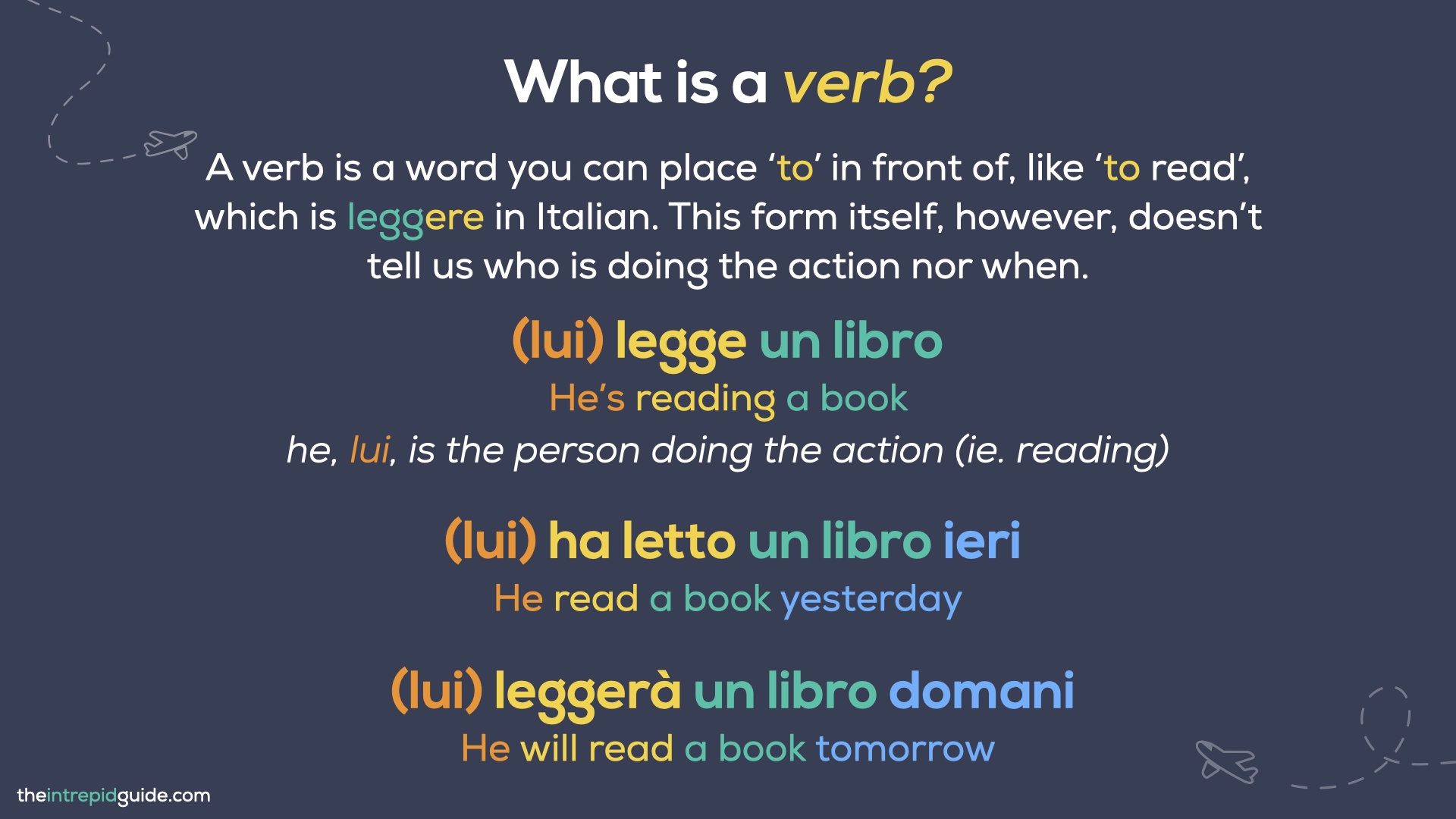
Italian Tenses and Modes
We’ll take a look at how to group Italian verb tenses into different categories, called ‘modes’. Each mode is basically a way of talking: am I expressing an opinion, giving advice, talking about future plans, making a wish, telling a story?
Each of these groups requires a different grammar structure, expressed by the mode (and tenses, which are subcategories of modes). The modes we need to know are: the indicative, the conditional, the imperative and the subjunctive.
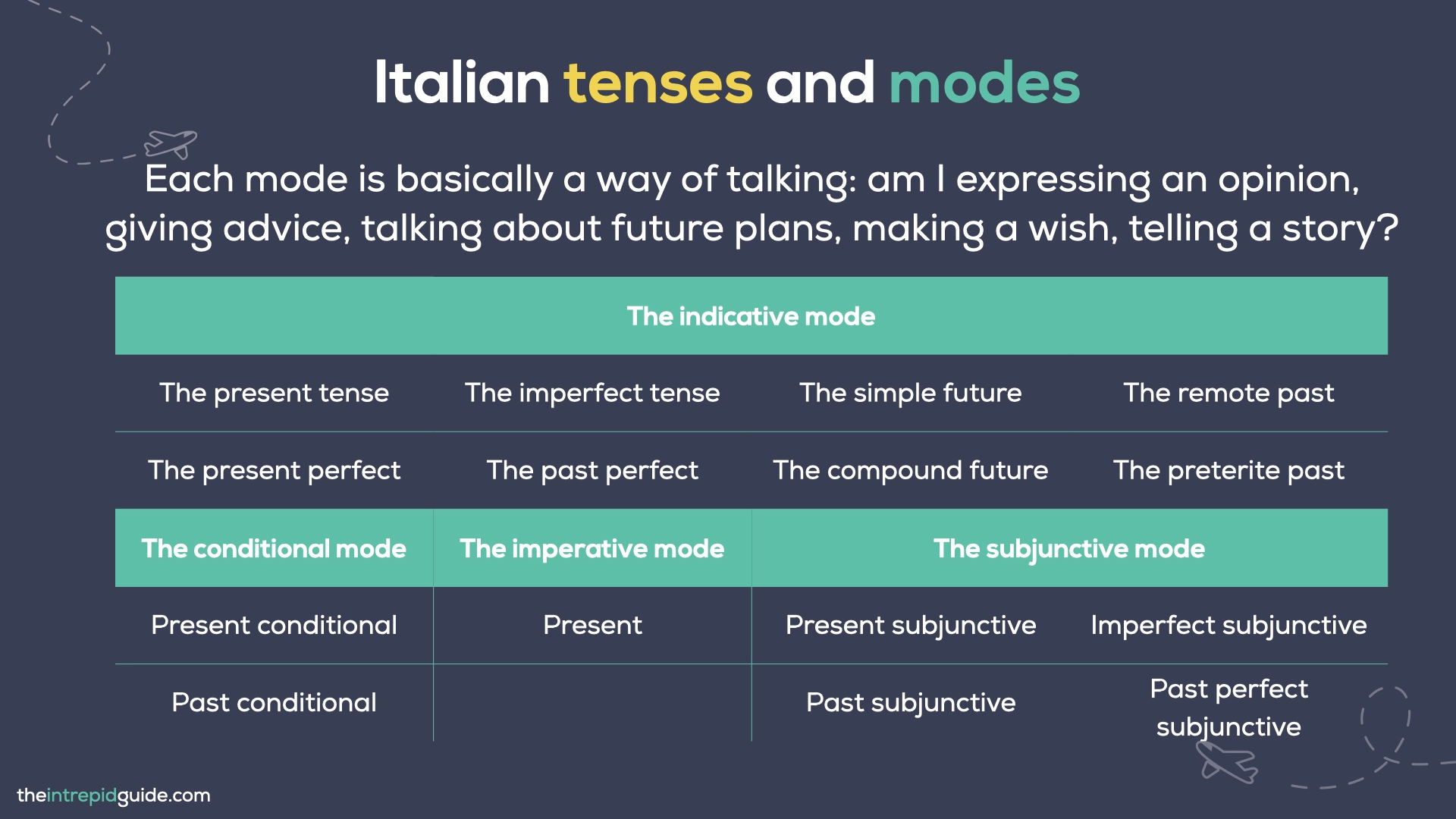
Itaian Verb Tenses Chart
Using the verb mangiare (to eat), here is how to conjugate it into all 15 Italian tenses.
| The Indicative Mode | |||
|---|---|---|---|
| Presente | Imperfetto | Futuro Semplice | Passato Remoto |
| mangio mangi mangia mangiamo mangiate mangiano | mangiavo mangiavi mangiava mangiavamo mangiavate mangiavano | mangerò mangerai mangerà mangeremo mangerete mangeranno | mangiai mangiasti mangiò mangiammo mangiaste mangiarono |
| Passato Prossimo | Trapassato Prossimo | Futuro anteriore | Trapassato Remoto |
| ho mangiato hai mangiato ha mangiato abbiamo mangiato avete mangiato hanno mangiato | avevo mangiato avevi mangiato aveva mangiato avevamo mangiato avevate mangiato avevano mangiato | avrò mangiato avrai mangiato avrà mangiato avremo mangiato avrete mangiato avranno mangiato | ebbi mangiato avesti mangiato ebbe mangiato avemmo mangiato aveste mangiato ebbero mangiato |
| The Subjunctive Mode | |||
| Presente | Imperfetto | Passato | Trapassato |
| mangi mangi mangi mangiamo mangiate mangino | mangiassi mangiassi mangiasse mangiassimo mangiaste mangiassero | abbia mangiato abbia mangiato abbia mangiato abbiamo mangiato abbiate mangiato abbiano mangiato | avessi mangiato avessi mangiato avesse mangiato avessimo mangiato aveste mangiato avessero mangiato |
| The Conditional Mode | The Imperative Mode | ||
| Presente | Passato | Presente | |
| mangerei mangeresti mangerebbe mangeremmo mangereste mangerebbero | avrei mangiato avresti mangiato avrebbe mangiato avremmo mangiato avreste mangiato avrebbero mangiato | – mangia! mangi! mangiamo! mangiate! mangino! | |
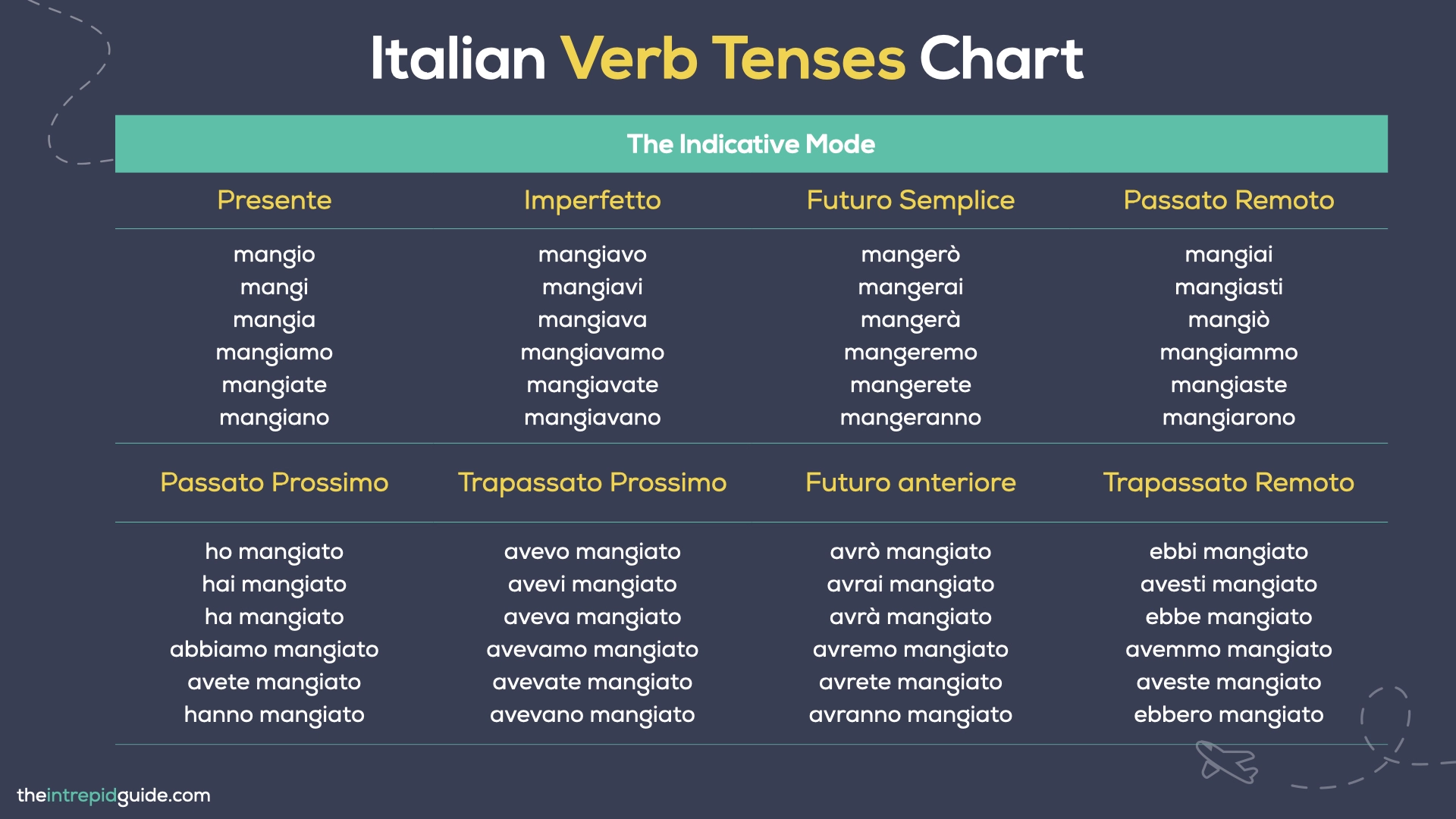
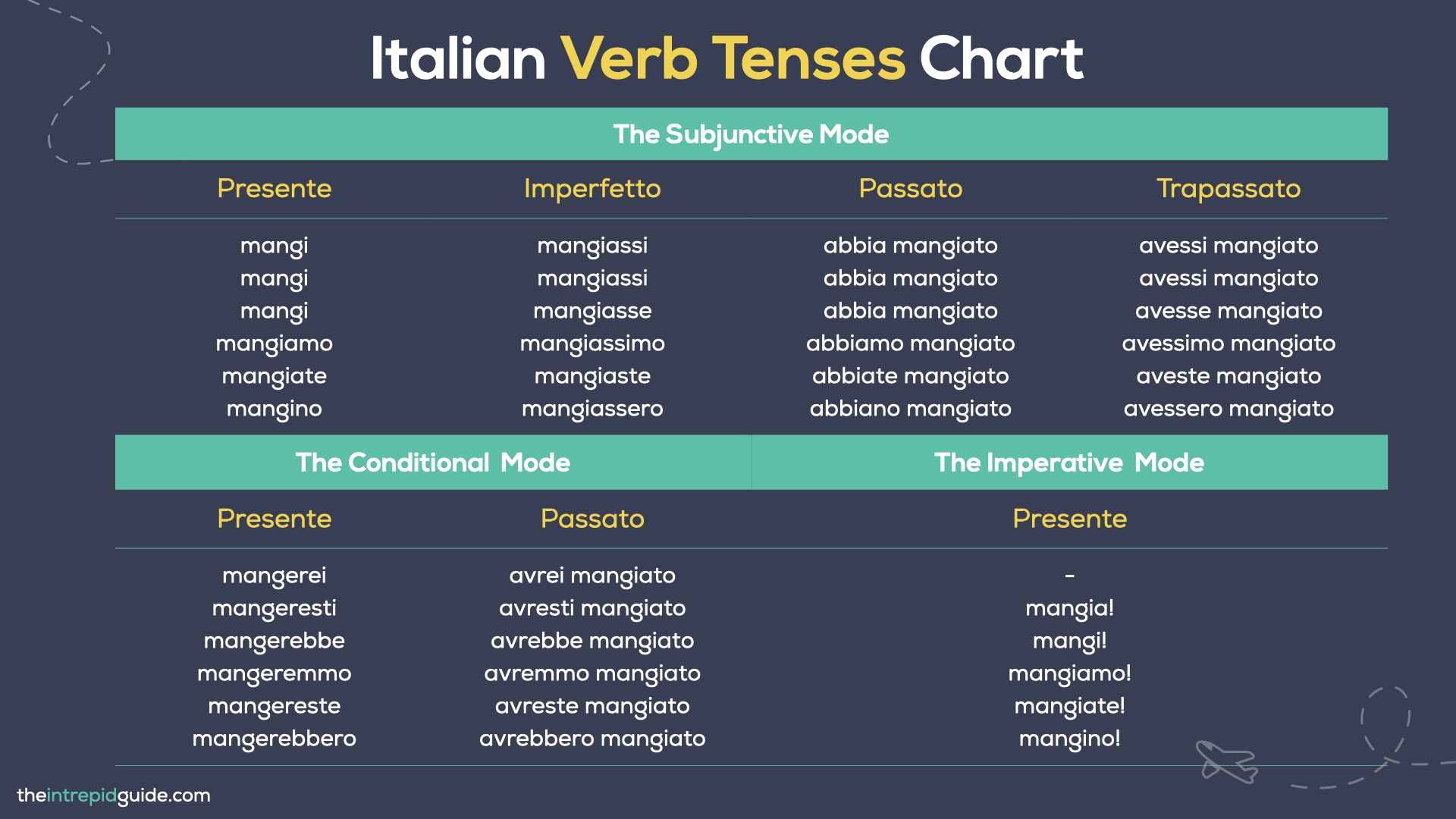
The Indicative Mode
The indicative mode is also called ‘the mode of reality’. It is used to express facts, statements, events in the past, present or future. It has eight different tenses. We’ll see them one by one.
The Present Tense (Presente)
The present indicative tense describes an action or situation that is happening right now, in the present time. The present tense is also used to express facts, universal truths and repeated actions in the present, to talk about fixed plans and something that will happen in the near future. It is the most common tense used in everyday conversation.
Here are some examples:
- L’acqua bolle a 100 gradi. (The water boils at 100 degrees.)
- Ogni giorno Giada va al lavoro in bicicletta. (Every day Giada goes to work by bike.)
- Mia madre lavora come infermiera. (My mother works as a nurse.)
- Il treno parte alle cinque in punto. (The train leaves at five o’clock.)
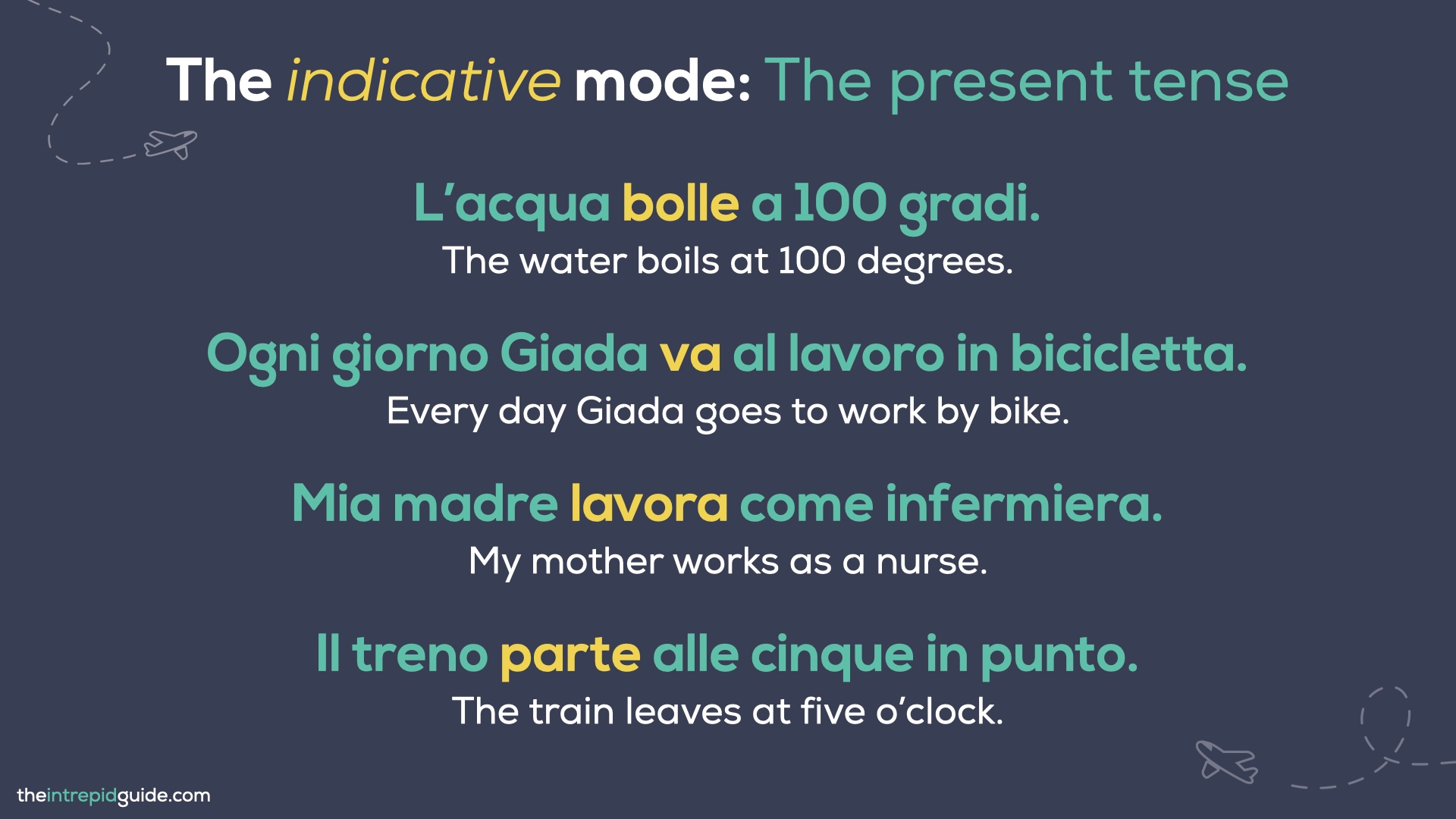
The Present Perfect (Passato Prossimo)
The passato prossimo is an Italian tense used to talk about past events. In particular, it describes events and actions that occurred at a definite time in the past and that have a beginning and an ending.
It is a so-called compound tense, because it is made of two parts. To understand this better, think of the English perfect tense, like ‘I have done’, ‘you have eaten’, ‘she has gone’, etc. The ‘have/has’ part in Italian is the present tense of essere or avere. The second word is the so-called past participle, similar to the English ‘–ed form’ (talked, worked, cooked) or ‘done’, ‘eaten’, ‘gone’, which in Italian is made by taking the infinitive of the verb (parlare, cadere, dormire) and by adding -ato, -uto, -ito to the stem of the verb after dropping the infinitive ending. So the past participles of parlare (to talk), cadere (to fall), and dormire (to sleep) are, respectively, parlato, caduto, dormito.
Attenzione! Some verbs have an irregular form, which must be learned by heart. Here are some of the most common:
- Fare → fatto
- Scrivere → scritto
- Leggere → letto
- Prendere → preso
- Dire → detto
Most verbs form the passato prossimo with avere. Other verbs form the passato prossimo with essere. Typically, these are verbs like svegliarsi, to wake up, lavarsi, to wash (oneself) etc. and verbs that are mainly used to talk about movement or a change of some kind, including: andare (to go), venire (to come), nascere (to be born), partire (to leave), uscire (to go out), diventare (to become), etc.
When essere is used to form the passato prossimo, the past participle agrees with the person of the verb in terms of gender and number. For example: Sono uscita con i miei amici. (I went out with my friends) → The person is lei, feminine singular.
Here are some more examples on verbs in the passato prossimo:
- Sabato scorso per cena ho mangiato la pizza. (Last Saturday I had pizza for dinner.)
- Ieri abbiamo incontrato la professoressa di italiano al mercato. (Yesterday we met the Italian teacher at the market.)
- Cristina è nata il 23 ottobre 1992. (Cristina was born on October 23, 1992)
Want to MASTER all Italian tenses?
Are you serious about learning Italian? Does deciding which tense to use stress you out? Imagine how you would feel if you could absorb all 15 Italian tenses naturally, so you can use them instinctively and effortlessly switch between tenses. Well, now you can! Introducing my Intrepid Italian 30-Day Tenses Challenge. Reach fluency faster with my daily video lesson and quizzes. To find out more, click here.
The Imperfect Tense (Imperfetto)
The Italian imperfect tense, l’imperfetto, is also used to talk about past events, but unlike the passato prossimo, we use it for descriptions, repeated actions, moods and feelings, childhood and in general, to give the context, frame or background of events in the past. It translates in English to ‘used to’.
Here are some examples:
- Da piccoli, io e mio cugino giocavamo sempre ai videogiochi. (When we were kids, my cousin and I played video games all the time.)
- Quando era giovane, mia mamma lavorava in una fabbrica di biscotti. (When she was young, my mom worked in a cookie factory.)
- La casa era grande e luminosa. (The house was big and bright.)
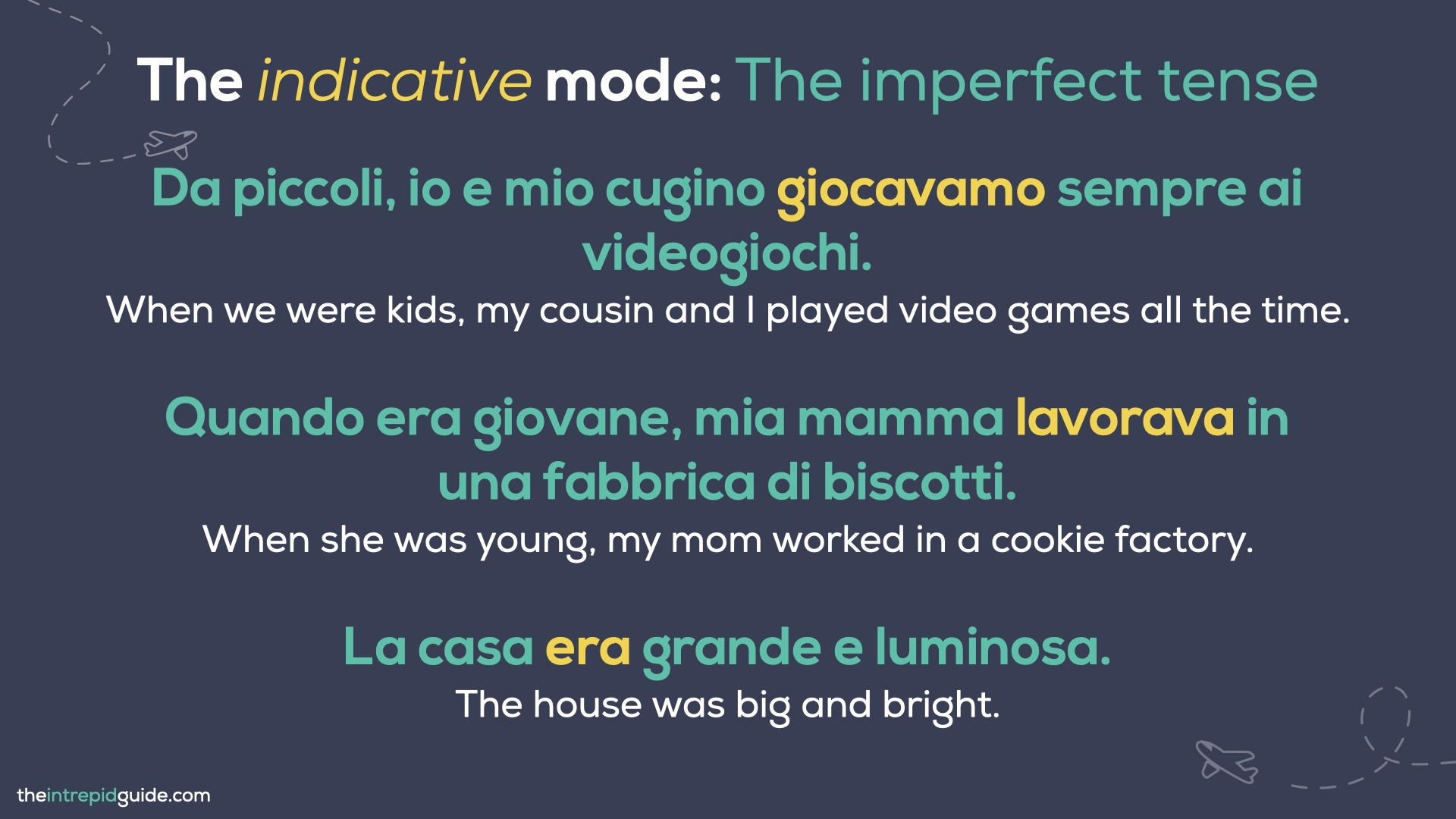
The Past Perfect (Trapassato Prossimo)
The past perfect tense, in Italian, trapassato prossimo, is like the English ‘I had said’, ‘you had gone’, ‘we had seen’, etc. It is used to describe a completed action that happened before another completed action in the past. It is a compound tense, formed by two pasts: the imperfect tense of essere or avere, and the past participle of the verb, e.g. eri uscito (you had gone out), avevo mangiato (I had eaten). It is often used in combination with other kinds of past tense.
Here are some examples:
- Quando Claudio è arrivato alla fermata dell’autobus, l’autobus era già partito. (When Claudio arrived at the bus stop, the train had already left.)
- Nessuno ci aveva detto cosa era successo. (No one had told us what had happened.)
- Alice si ricordava di Luca, l’aveva conosciuto cinque anni prima. (Alice remembered Luca, she had met him five years earlier.)
The Simple Future (Futuro Semplice)
We use the future to talk about something that will happen or that will be true, however the simple future in Italian is not used as extensively as the English future with ‘will’ or ‘going to’. In Italian, the simple future expresses the idea of a distant or uncertain future, more than a fixed plan. Here are some examples:
- Da grande, Giulio farà il pilota. (When he grows up, Giulio will be a pilot.)
- Tra qualche anno cambierò la macchina. (In a few years I will change the car.)
- Dopo la scuola, Linda frequenterà l’Accademia delle belle Arti. (After school, Linda will attend the Academy of Fine Arts.)
The Compound Future (Futuro Anteriore)
As the name suggests, the compound future is a compound tense, formed by the simple future of essere or avere and the past participle of the verb. Often used in combination with the simple future, it indicates an action that happens before the action expressed by the simple future. It also translates the English ‘will have + -ed’. For example:
- Dopo che avrò preparato la valigia, potrò riposarmi. (After I pack my suitcase, I can rest.)
- Tra una settimana come oggi, avrai già fatto l’esame. (In a week like today, you will have already taken the exam.)
- Non appena saremo arrivati a destinazione, vi chiameremo. (As soon as we arrive at our destination, we will call you.)
The Remote Past (Passato Remoto)
The Italian remote past, or passato remoto, is another past tense. In writing, the remote past is mostly found in literature and narrative, to talk about historical facts and events. In speaking, it is used almost exclusively in Southern Italy, while in the North the passato prossimo tense is preferred.
Here are some examples:
- Dante scrisse la Divina Commedia. (Dante wrote the Divina Commedia.)
- Mia nonna nacque negli Stati Uniti. (My grandma was born in the US.)
- Chiamai Elisabetta per darle la notizia. (I called Elisabetta to tell her the news)
The Preterite Past (Trapassato Remoto)
The preterite past, or trapassato remoto in Italian, is even rarer than the remote past, as it refers to an action that took place in the past, long ago, before another action introduced by the passato remoto. In writing, it adds a more sophisticated nuance to the sequence of actions, but you will never find it in spoken Italian. Here are some examples:
- Solo dopo che ebbe scoperto il suo tradimento, decise di vendicarsi. (Only after he discovered his treachery did he decide to take revenge.)
- Dopo che ebbero ucciso il re, scoppiò la rivolta. (After they had killed the king, revolt broke out.)
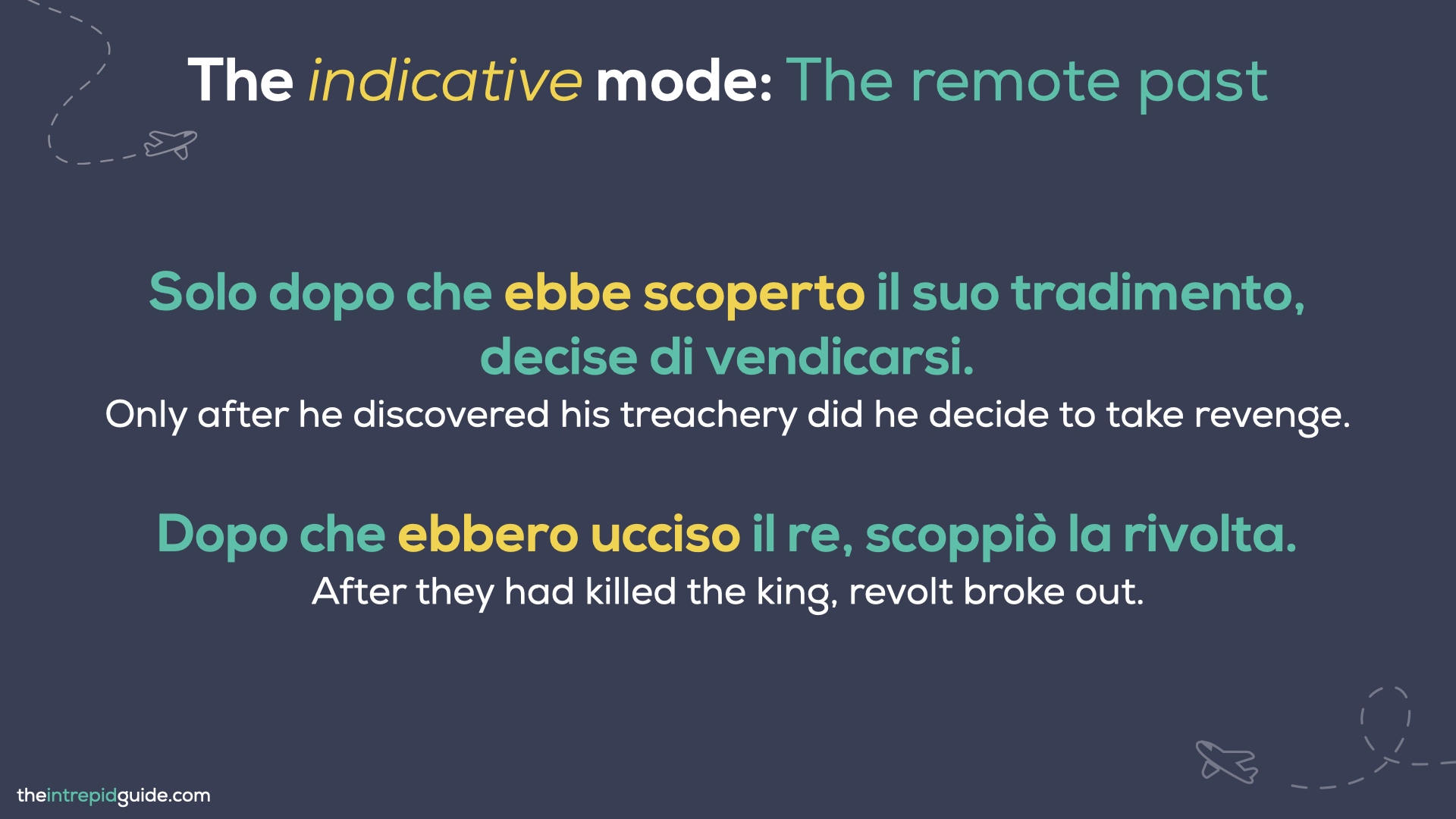
The Conditional Mode
The conditional is the mode of wish and desire. It is used to express what we would, should, could do. The conditional mode has two tenses: the present and the past conditional.
Present conditional (Condizionale Presente)
We use the present conditional to express a desire, a wish, to make a request in a polite way, to express uncertainty, personal opinions, probabilities, or to give advice, in relation to the present time. Here are some examples:
- Vorrei un bicchiere d’acqua, per favore. (I would like a glass of water, please.)
- Gli piacerebbe comprare una casa al mare. (He would like to buy a house by the sea.)
- Potrebbe ripetere, per favore? (Could you repeat that, please?)
- Cosa faresti al mio posto? (What would you do in my place?)
- Non dovresti mangiare così di fretta. (You shouldn’t eat in such a hurry.)
- Il corriere potrebbe arrivare tra le 2 e le 4. (The courier could arrive between 2pm and 4pm.)
Past Conditional (Condizionale Passato)
Similarly to the present conditional, the past conditional expresses desire, wish or possibility, but in the past. The only case when we can’t use the past conditional is to make a polite request. The past conditional describes something that could have, might have, should have happened and that can’t be changed anymore. That is why it is often followed by a sentence introduced by ma (but), tuttavia (however) – to show the contrast with reality.
From a grammatical point of view, the past participle is a compound tense: it is formed by the present conditional of the verbs essere and avere plus the past participle of the verb.
Here are some examples of the past conditional used in context:
- Giovanni sarebbe andato in palestra, ma non ha avuto tempo. (Giovanni would have gone to the gym, but he didn’t have time.)
- Le sarebbe piaciuto crescere in montagna invece che in città. (She would have liked to grow up in the mountains instead of the city.)
- Vi avremmo avvisato con un messaggio, ma non c’era campo. (We would have notified you with a message, but there was no service.)
- Non avrei dovuto spendere così tanti soldi. (I shouldn’t have spent so much money.)
- Avrebbero voluto studiare in Italia. (They would have liked to study in Italy.)
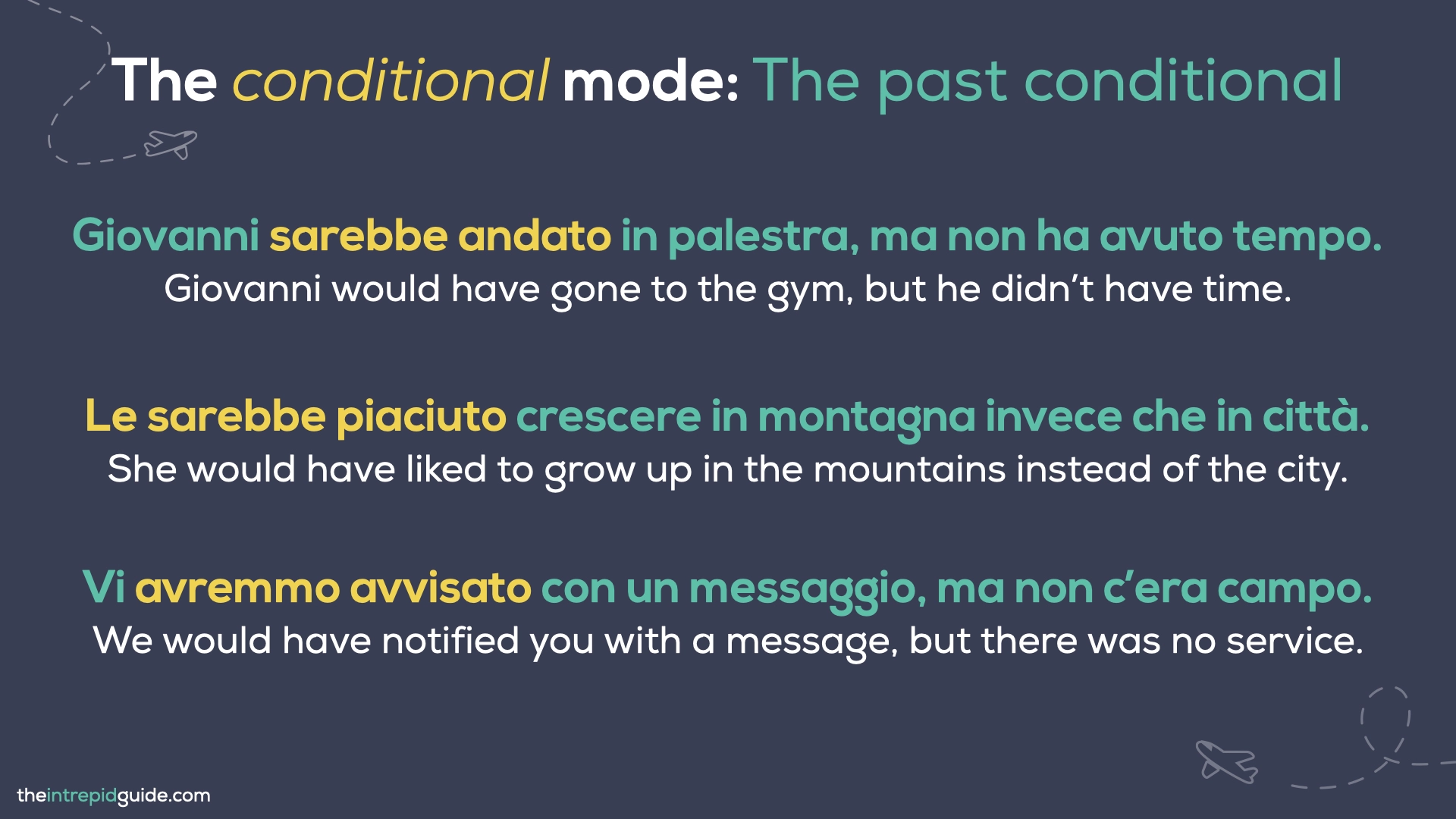
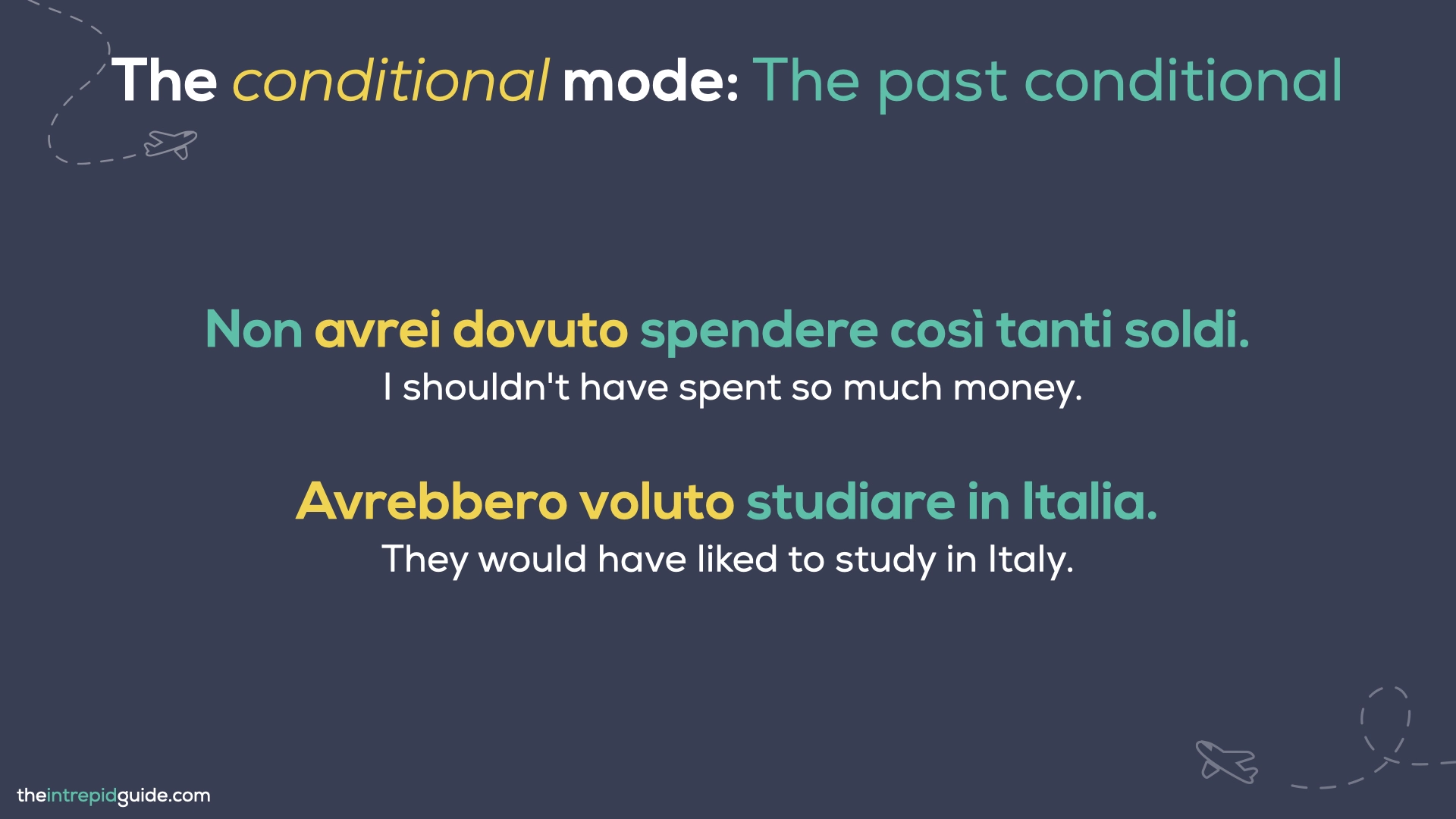
The Imperative Mode
The imperative mode is used to give advice, orders, commands, suggestions in a direct way. Depending on the tone used and the context, imperative sentences can be interpreted as more or less rude. The imperative mode only has one tense, the present tense. Unlike other tenses, you can’t use all the subjects in the imperative, but only: tu, Lei, noi and voi.
A verb in the imperative in Italian looks like this:
- Mangia! (Eat!)
- Non abbia paura! (Don’t be afraid! f.)
- Andiamo a fare un aperitivo! (Let’s go have an aperitif!)
- Aiutate i vostri genitori! (Help your parents! pl.)
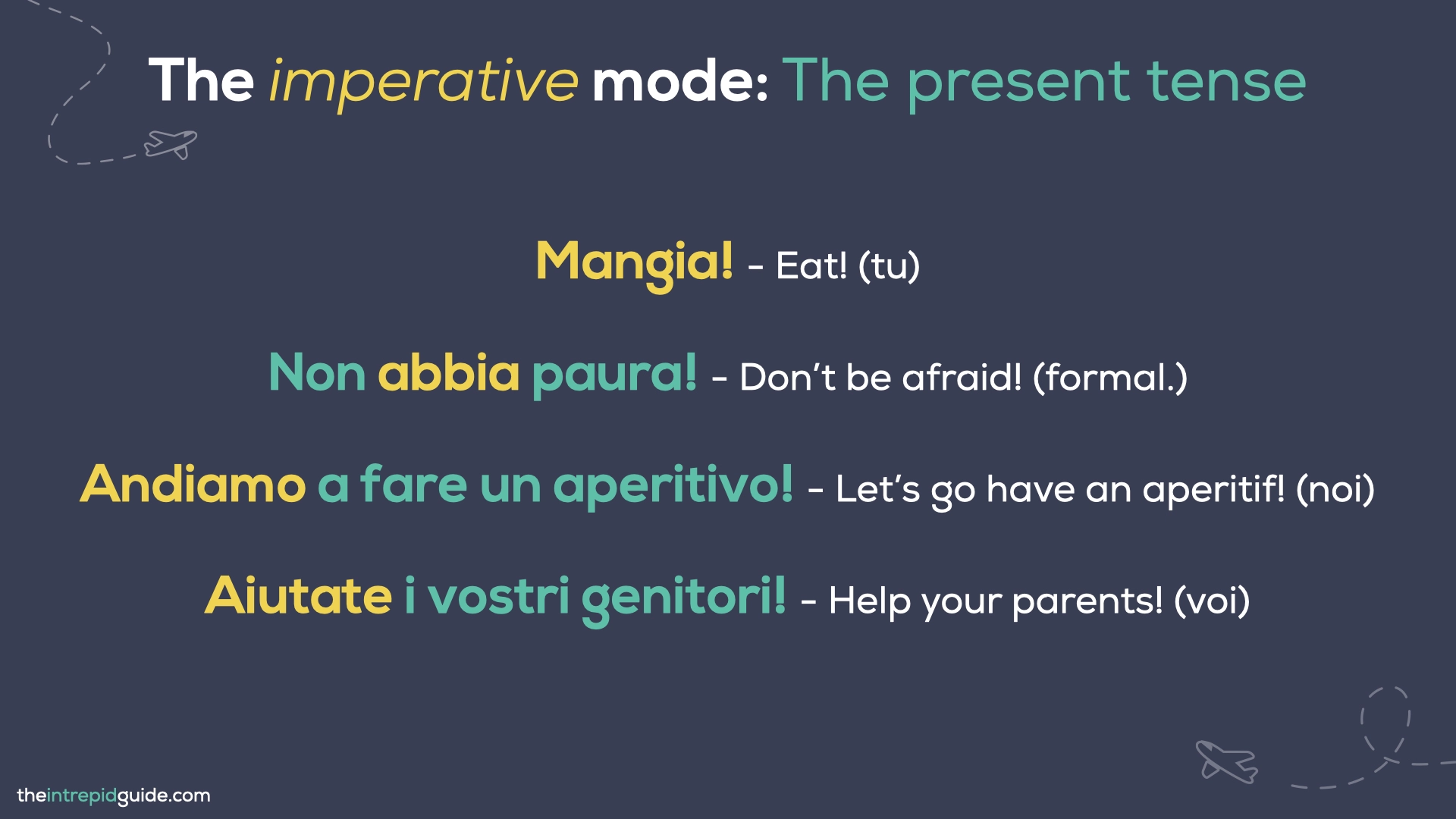
The positive imperative uses the same forms of the present indicative tense for the persons tu, noi and voi, but the present subjunctive (we’ll see this in a minute) is used for Lei. Note that with verbs ending in –are, in the tu form we have to add an ‘a’ to the ending.
The negative imperative is formed by placing ‘non’ in front of the verb. In the tu form, we use the infinitive form of the verb (the full verb), while all the other persons keep the same form of the positive imperative. For example:
- Non dimenticare il passaporto! (Don’t forget your passport!)
- Non tornate troppo tardi! (Don’t come back too late!)
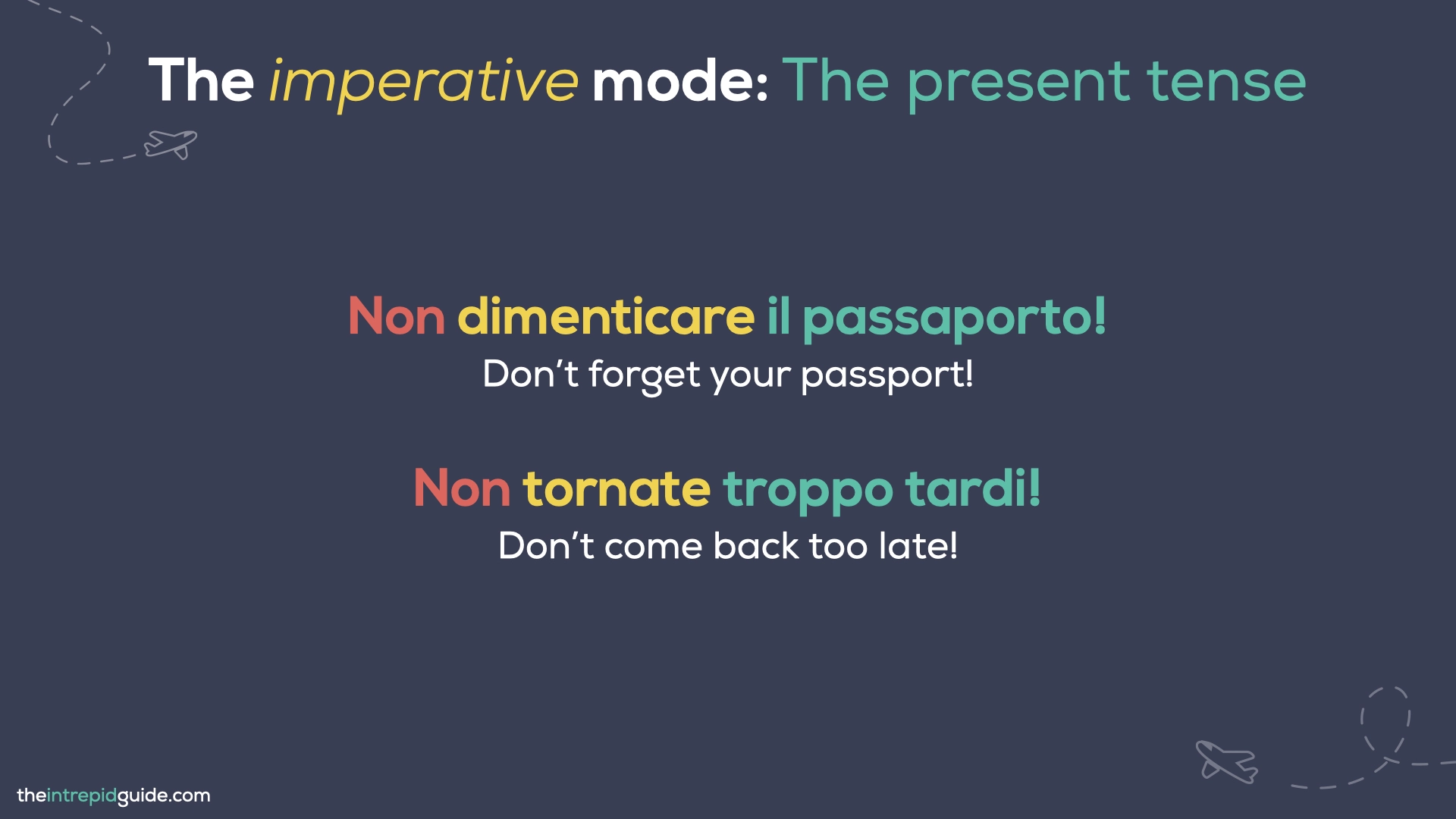
There are also verbs with an irregular imperative form, and verbs, which allow two forms, one regular and one irregular. Typically, these are short verbs, like dare, fare, dire, stare, but also andare, sapere. For example:
- Fa’/Fai una doccia! (Take a shower!)
- Di’ la verità! (Tell the truth!)
- State calmi! (Be quiet! pl.)
- Vada in fondo alla fila! (Go at the end of the line! f.)
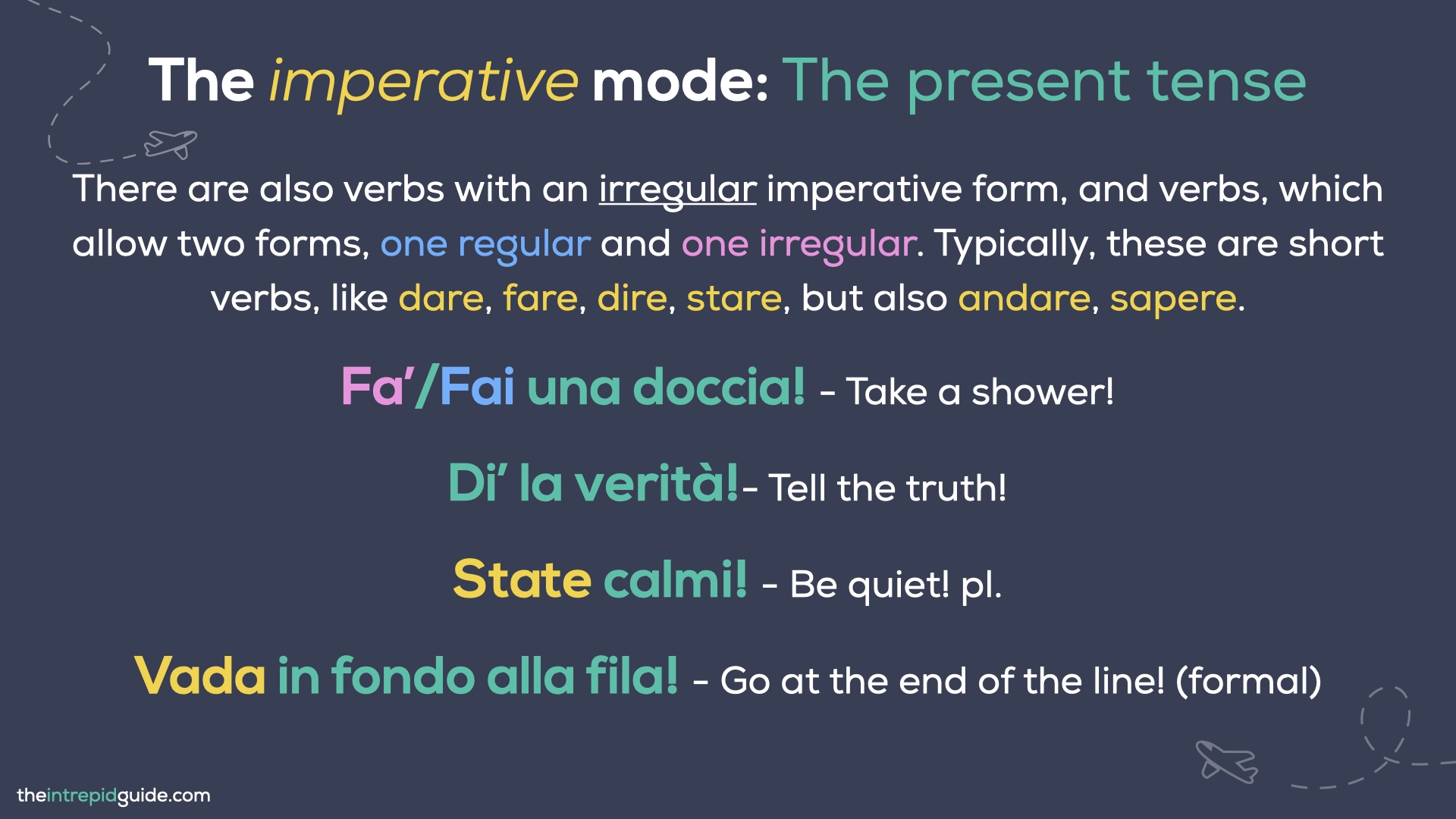
You can make an imperative sentence sound more polite by placing per favore at the end or by adding pure and prego, as in: Si sieda pure! (Please take a seat! f.); Rrego, entrate! (please, come in!); Inizia pure! (you may start!).
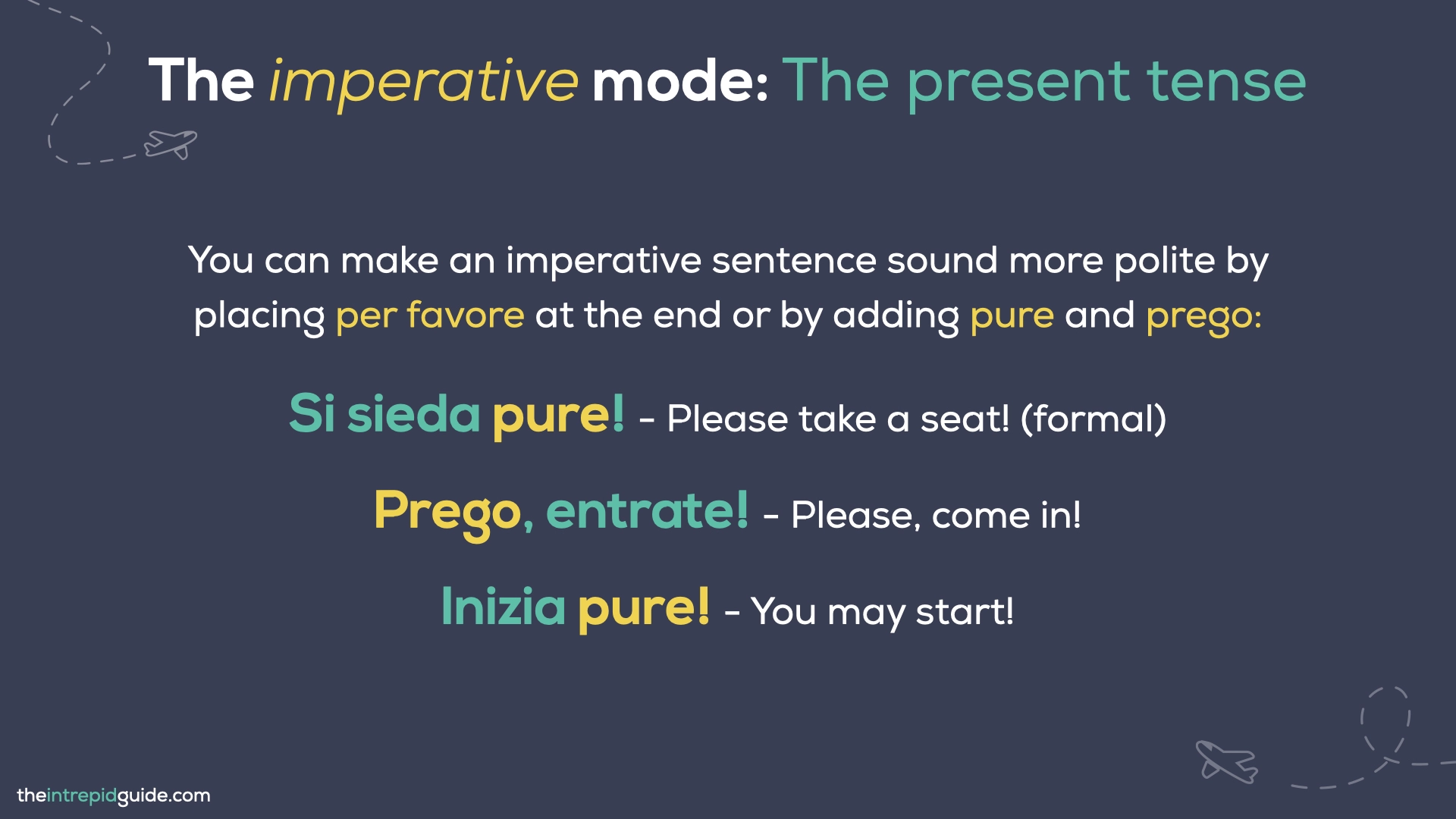
The Subjunctive Mode
The last mode is the subjunctive, in Italian: il congiuntivo. Probably the most dreaded mode by learners of Italian, the subjunctive is the mode of unreality, hypothetical situations and impossibility. It is used to express opinions, feelings, hope, and uncertainty and with fixed phrases.
There are four tenses in the subjunctive: the present, the past, the imperfect and the past perfect.
Present Subjunctive (Congiuntivo Presente)
There are many cases where the present subjunctive needs to be used. This includes: verbs of opinion, hope, uncertainty, fear, doubt, feelings, expressions like sono felice/triste che… (I’m happy/sad that…), è necessario che…/bisogna che… (it is necessary that…), words like nonostante/benché (although), expressions like ‘the more/less … than’. The present subjunctive is used when the verb before che is in the present indicative tense. Here are some examples:
- Penso che lui dica la verità. (I think he is telling the truth.)
- Preferisce che tu vada con lei. (She prefers you to go with her.)
- Non è sicuro che ci sia anche Paola alla festa. (It’s not certain that Paola will be at the party too.)
- Nonostante faccia caldo, Luisa indossa una giacca. (Although it is hot, Luisa is wearing a jacket.)
- Lorenzo è la persona più simpatica che conosca. (Lorenzo is the nicest person I know.)
Attenzione! A clarification needs to be made here. The word che is not necessarily an indicator that the subjunctive has to be used. Even though this is true most of the time, remember that the subjunctive expresses uncertainty, so when something is certain like in the following sentence, we don’t need the present subjunctive, but the present indicative instead: so che tu sei una brava persona (I know you are a good person). According to the speaker, this is not an opinion, it’s a fact!
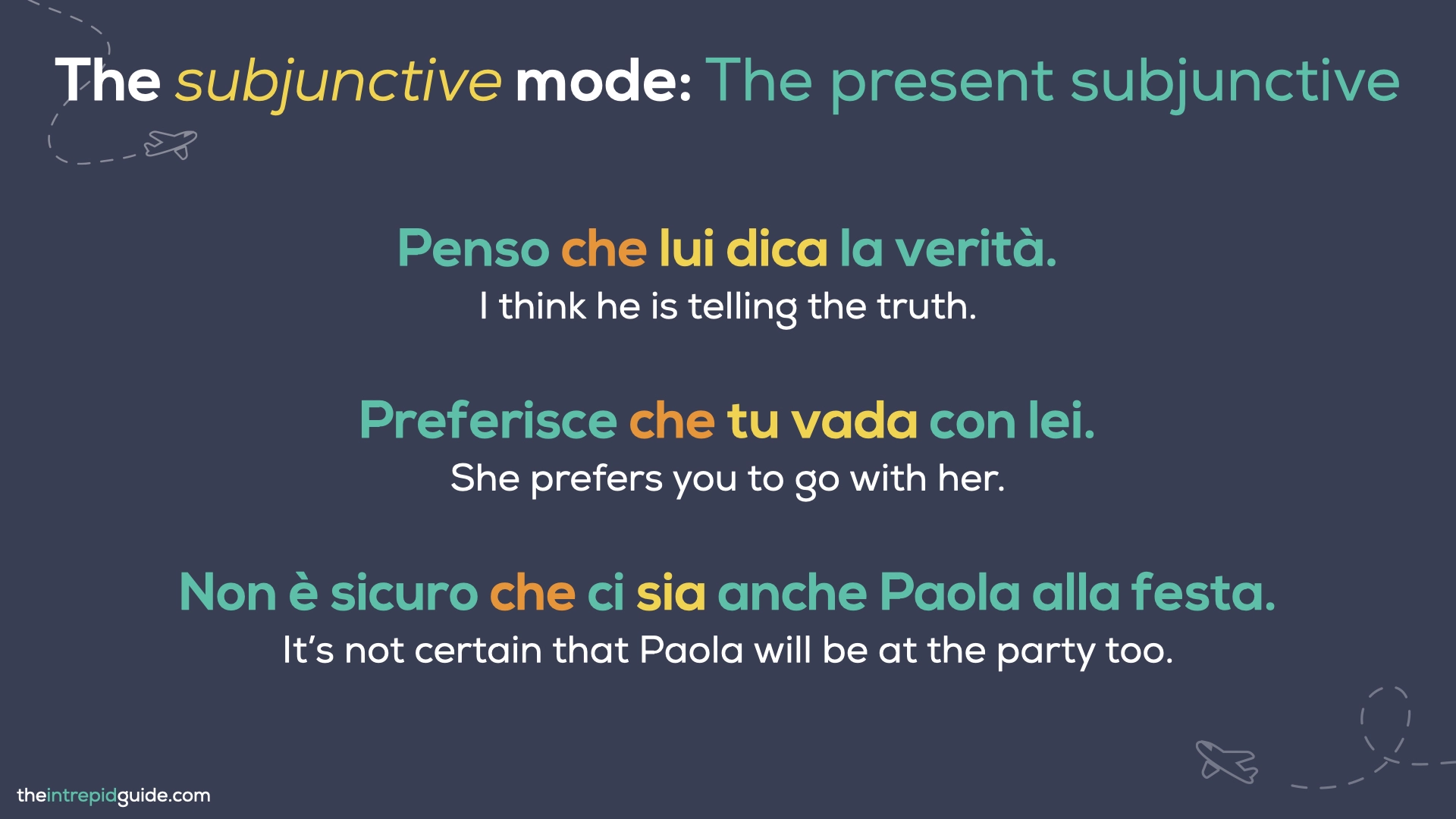
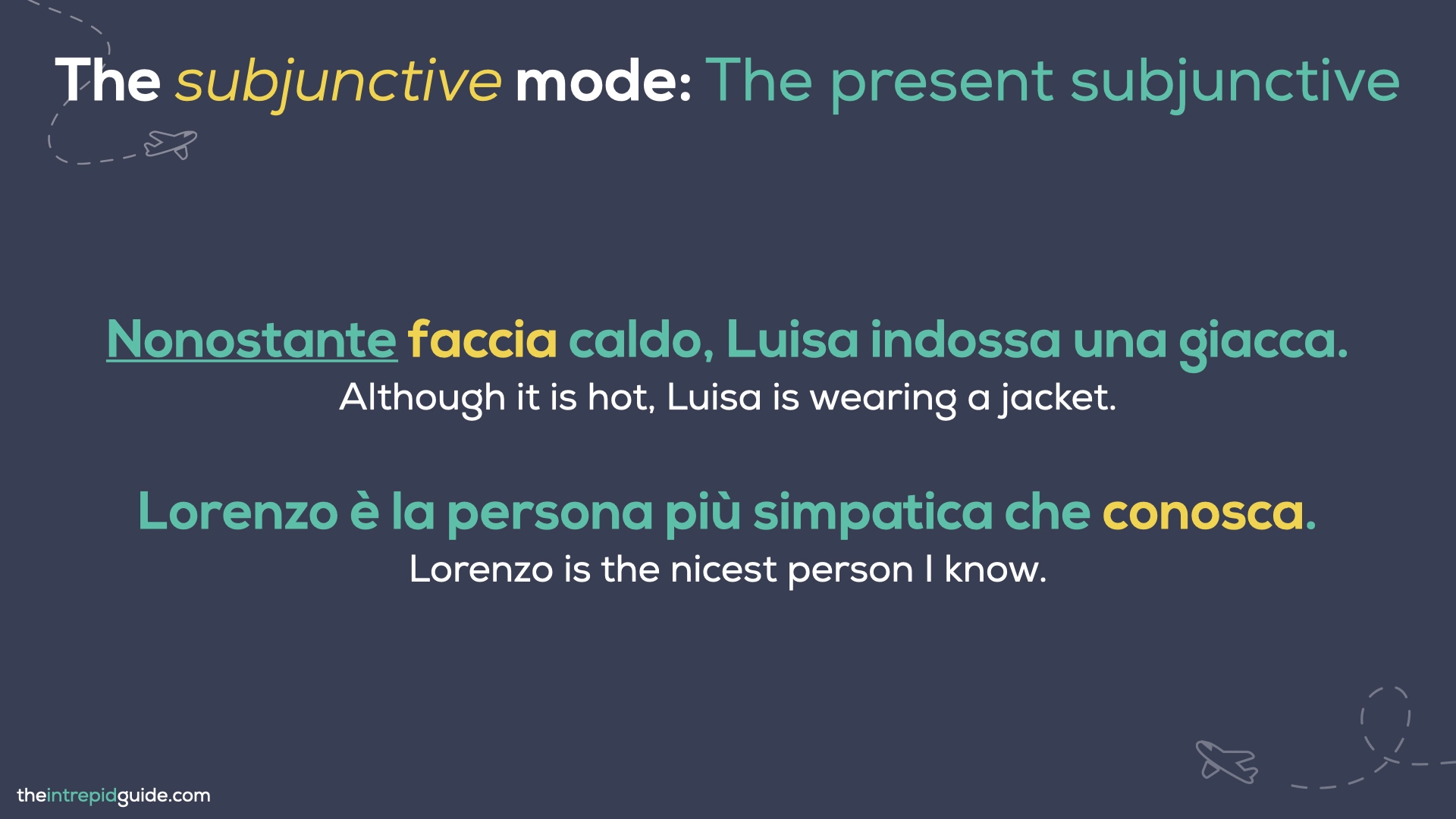
Past Subjunctive (Congiuntivo Passato)
The past subjunctive is a compound tense, so it is formed by two words: the present subjunctive of essere or avere and the past participle of the verb. It is used in the same cases of the present tense. The past subjunctive is used to express a past action that happened before another action described with the present indicative tense verb in the sentence before che. This time relationship between the two verbs is called anteriority. Here are some examples:
- Spero che abbiate già mangiato. (I hope you have already eaten.)
- Sembra che Giorgio abbia conosciuto una ragazza alla festa. (It seems that Giorgio has met a girl at the party.)
- Temo che Rita si sia dimenticata di farmi gli auguri. (I’m afraid Rita forgot to wish me a happy birthday.)
- Nonostante io le abbia detto di venire alle 9, Clara è arrivata alle 9 e mezza. (Although I told her to come at 9 o’clock, Clara arrived at 9:30.)
- Questa è la cosa più bella che abbia mai visto. (This is the most beautiful thing I have ever seen.)
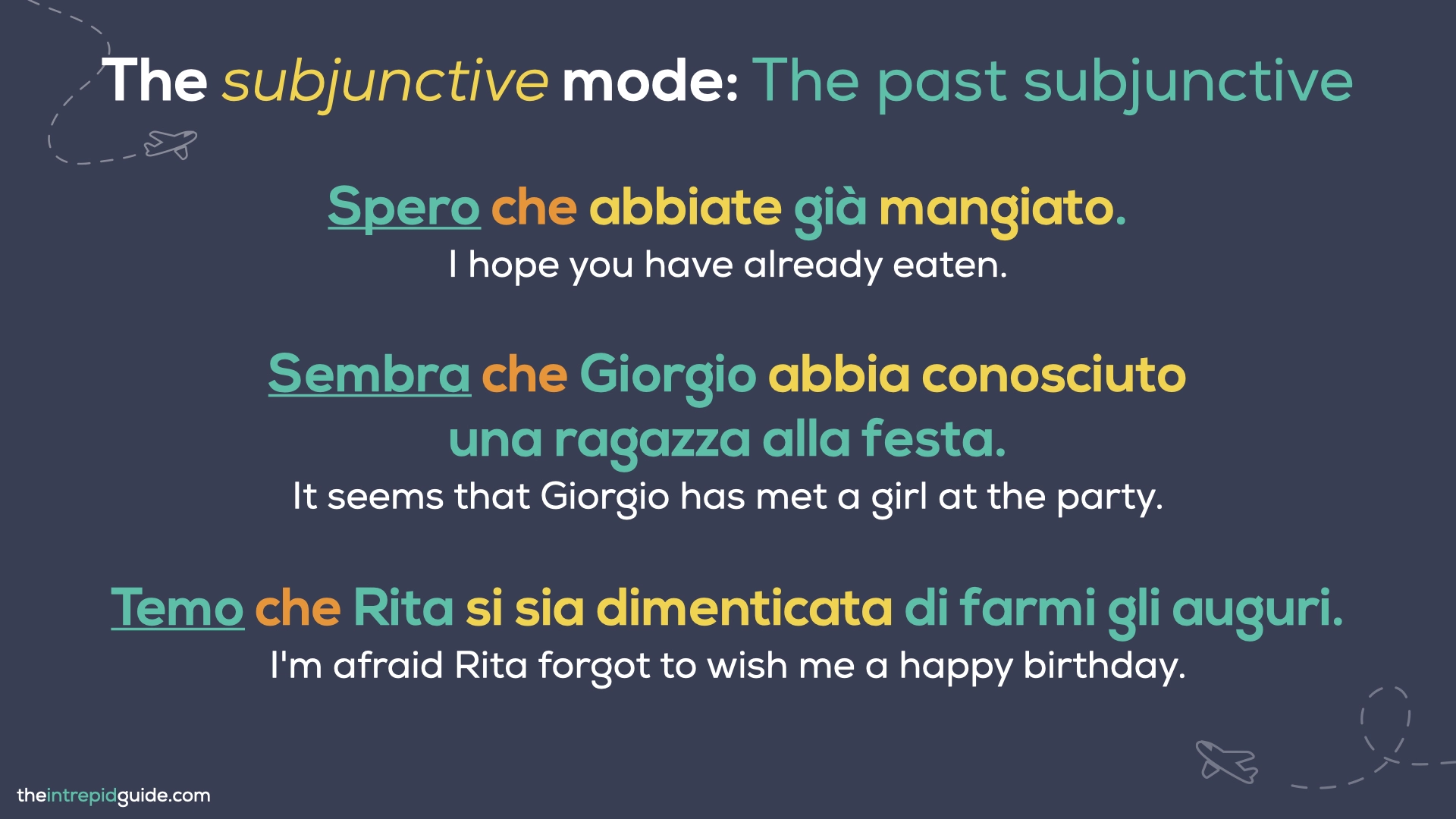
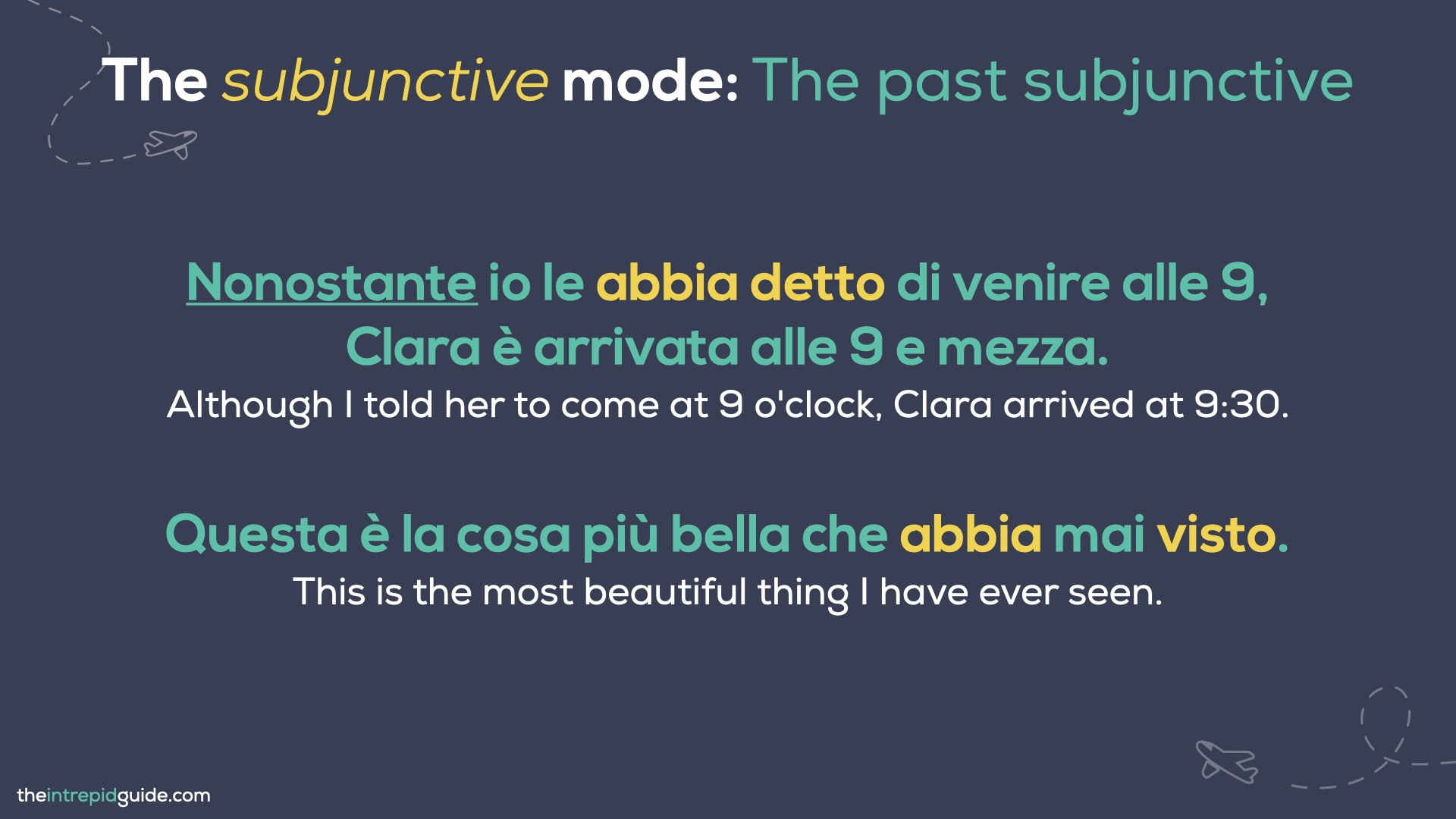
Imperfect Subjunctive (Congiuntivo Imperfetto)
Similarly to the present subjunctive, the imperfect subjunctive is a simple tense (meaning, it has only one word). It is used with the same kind of verbs that we saw for the present subjunctive (sperare, to hope, credere/pensare, to believe) and the same grammar structures, but this time the verb before the che is in the imperfect indicative tense. See the following examples:
- Era necessario che tu mi chiamassi. (It was necessary for you to call me.)
- Speravo che la nostra relazione non finisse mai. (I hoped our relationship would never end.)
- Avevamo paura che l’esame fosse andato male. (We were afraid that the exam had gone wrong.)
- Sembrava che Greta fosse triste. (It seemed that Greta was sad.)
- Sebbene fosse malata, Giulia è andata al colloquio di lavoro. (Although she was sick, Giulia went to the job interview.)
The imperfect subjunctive can be also found in hypothetical sentences expressing possibility, as in: Se avessi un lavoro meno stressante, sarei più felice (If I had a less stressful job, I’d be happier). As you can see, in this type of sentence, the imperfect subjunctive is used in combination with the present conditional tense.
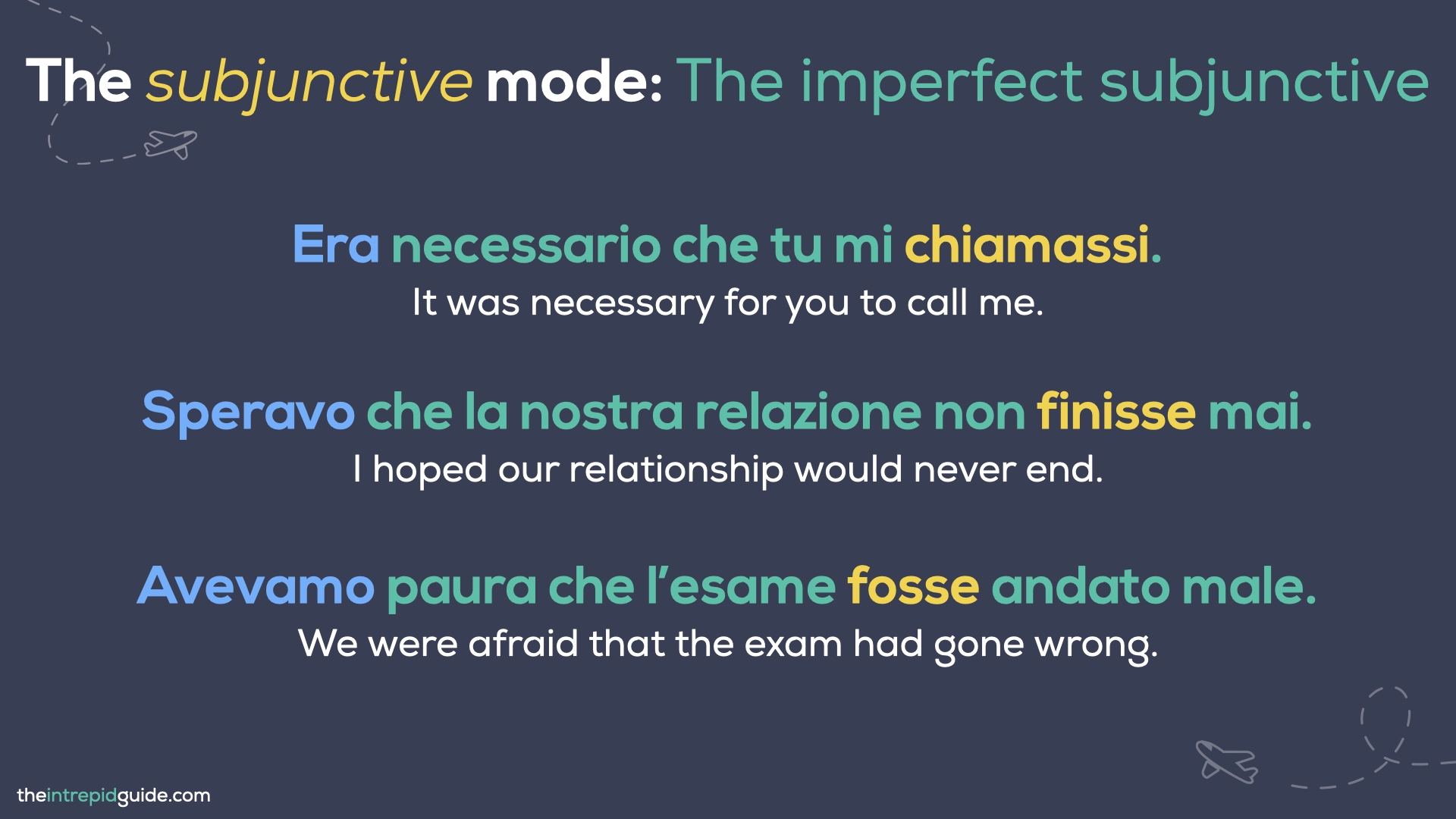
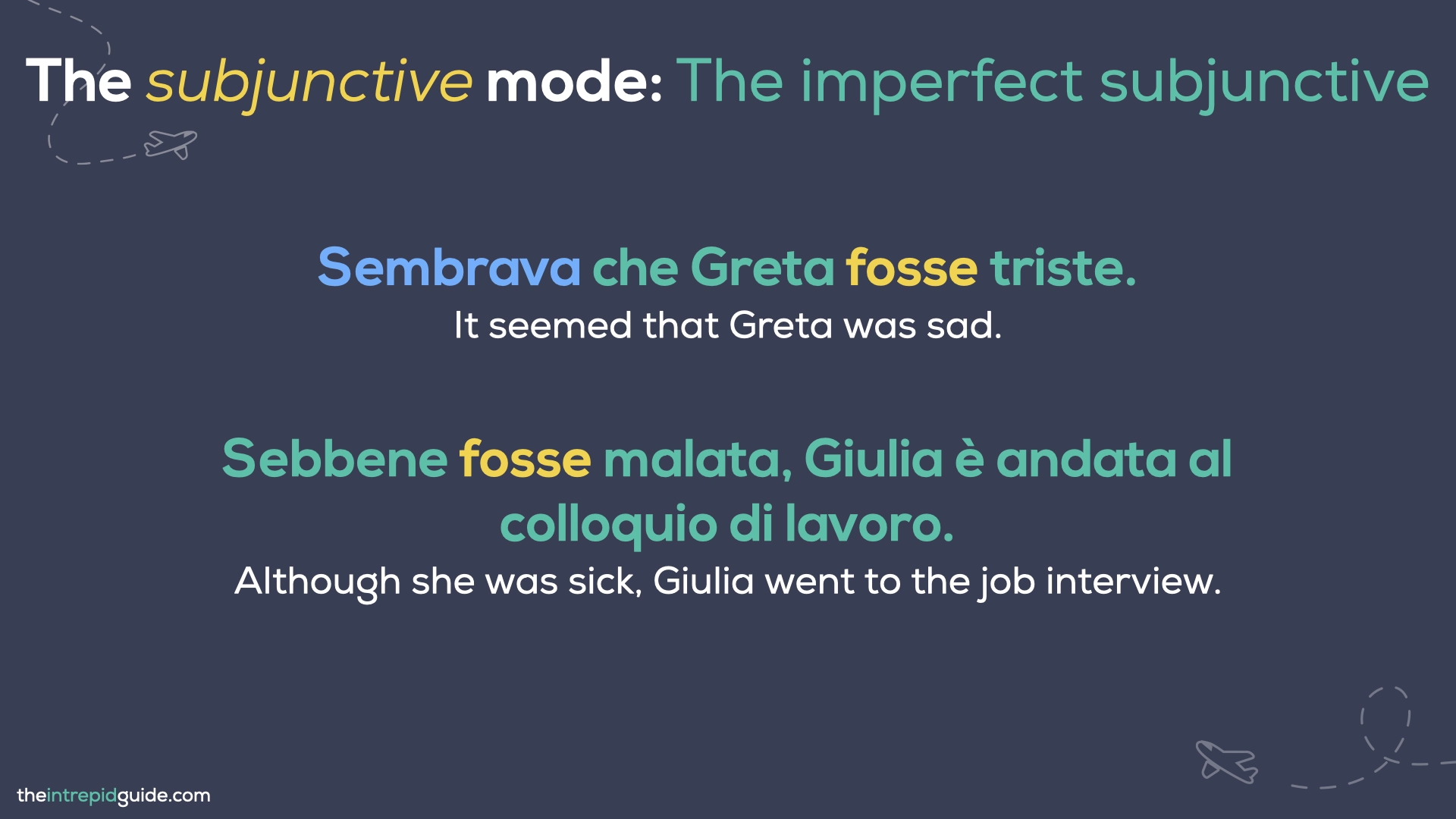
Past Perfect Subjunctive (Congiuntivo Trapassato)
The past perfect subjunctive is a compound tense, formed by the imperfect subjunctive of essere or avere plus the past participle of the verb. Just like the past subjunctive, the past perfect subjunctive is used to express a relationship of anteriority with the verb before the che. So, the action expressed by the subjunctive occurred before the action expressed by the other verb (usually in the past conditional, imperfect indicative or passato prossimo tense). Here are some examples:
- Pensavamo che Roberta e Lucia si fossero già incontrate prima. (We thought Roberta and Lucia had met before.)
- Ero contento che mi avessero dato quel lavoro. (I was glad they had given me that job.)
- Aveva paura che lui le avesse mentito. (She was afraid that he had lied to her.)
- Pareva che non si fossero accorti dell’accaduto. (They didn’t seem to notice what had happened.)
- Speravamo che tutti si fossero divertiti alla festa. (We hoped everyone had had a good time at the party.)
The past perfect subjunctive can be also found in hypothetical sentences expressing impossibility, as in: Se fossi stato al tuo posto, mi sarei licenziato (If I had been in your place, I would have quit the job). As you can see, in this type of sentence, the past perfect subjunctive is used in combination with the past conditional tense.
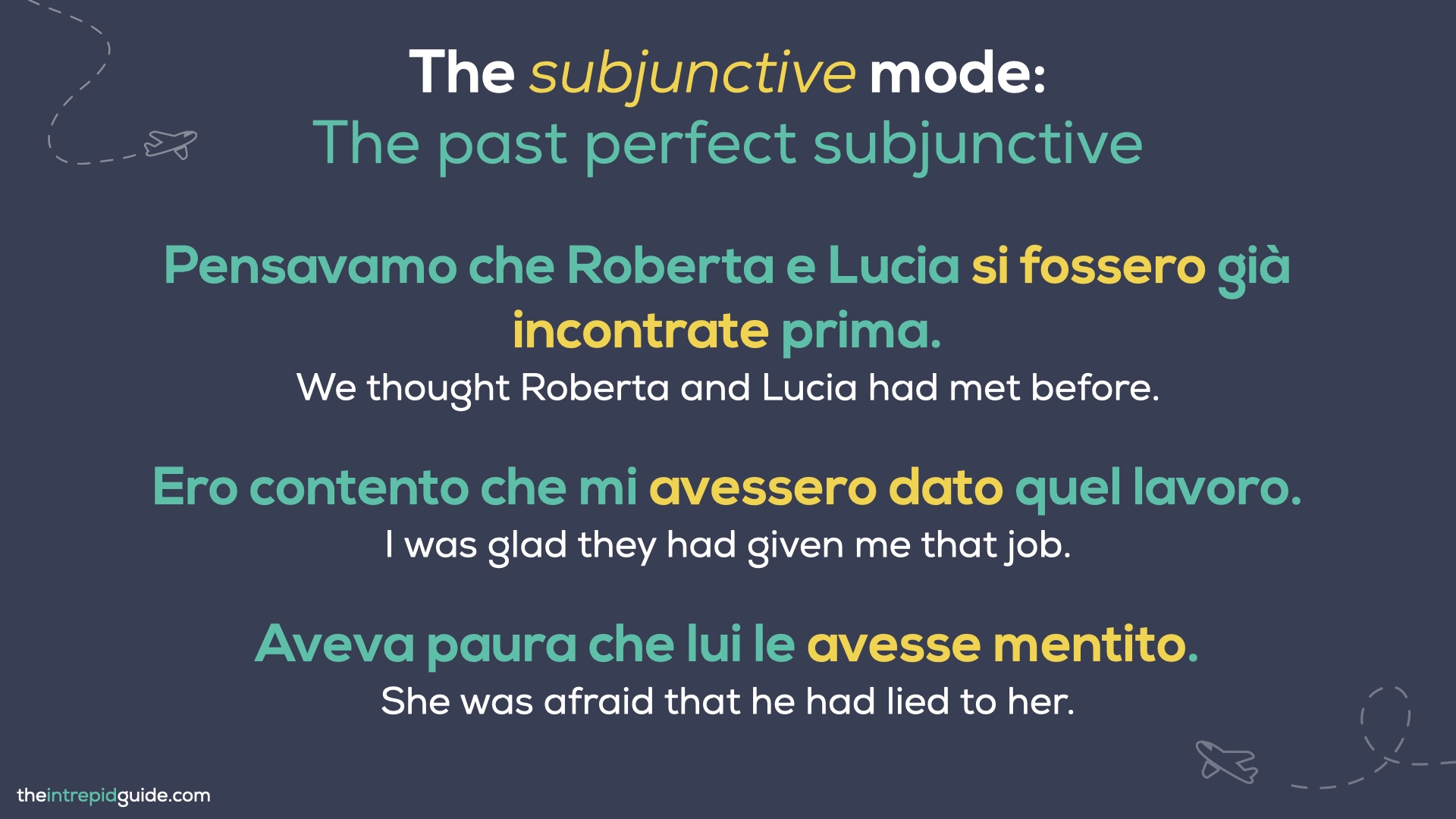
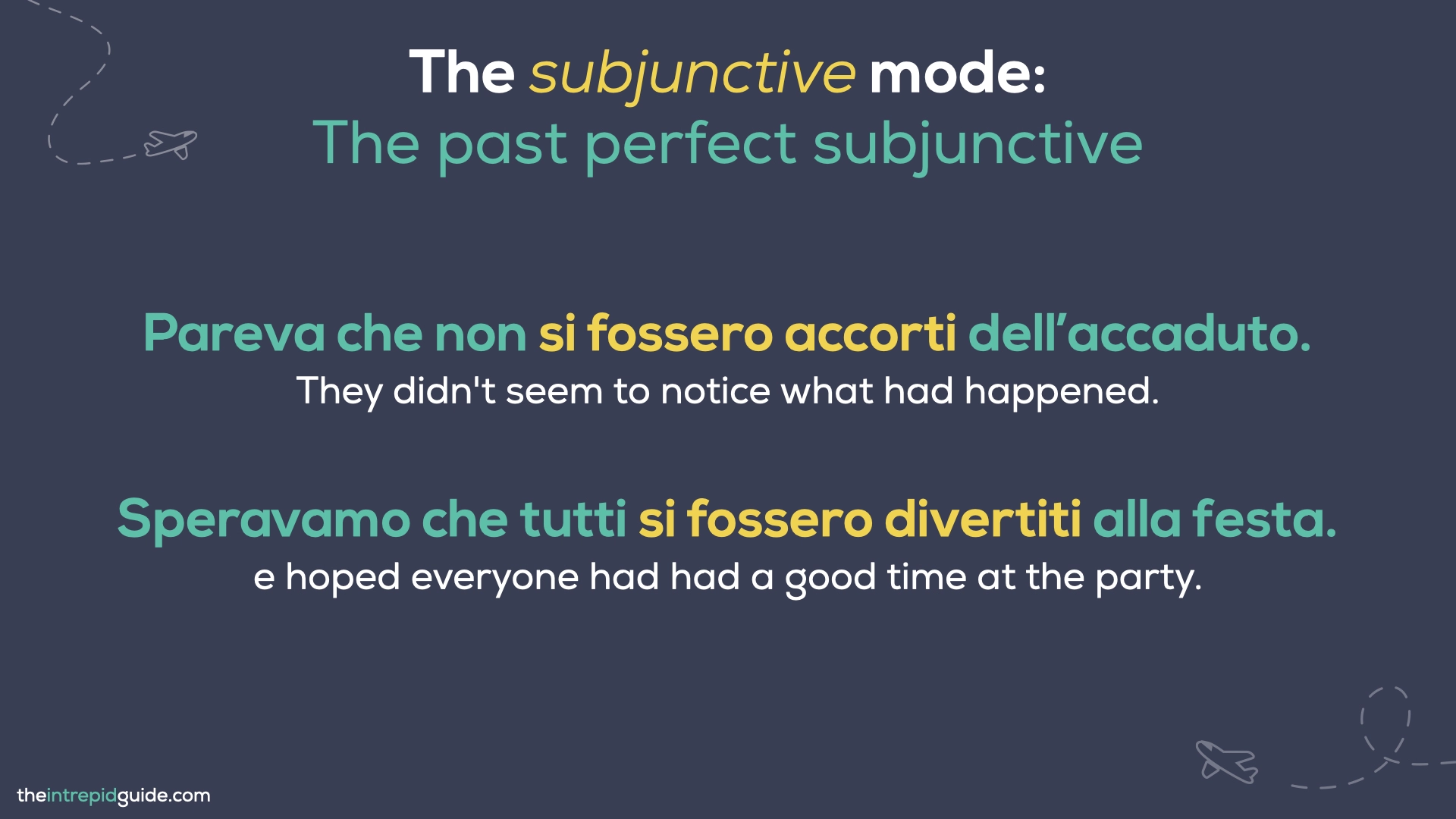
Do you feel lost choosing between all 15 Italian tenses?
Do you want to feel confident, and master all Italian tenses that native speakers use in everyday conversation? Now you can! Introducing my Intrepid Italian 30-Day Tenses Challenge. Crack the code and understand how and when to use ALL Italian tenses, with daily lessons, exercises and plenty of examples.
Over the course of the month, the daily immersion will help you absorb all 15 fluency-boosting Italian tenses naturally, so you can effortlessly switch between using each of them. You’ll begin to feel more confident speaking Italian without worrying constantly doubting yourself.
- ✅ No more blank looks
- ✅ No more wondering which tense to use
- ✅ And most importantly… no more constantly doubting yourself
Imagine what it will feel like when you speak Italian and you instinctively KNOW which tense to use? Incredibile, right!?
Cosa aspetti? What are you waiting for? Registrations are now open to join the Intrepid Italian 30-Day Tenses Challenge. Master all Italian tenses naturally and reach fluency faster with daily lessons and quizzes. To find out more, click here.
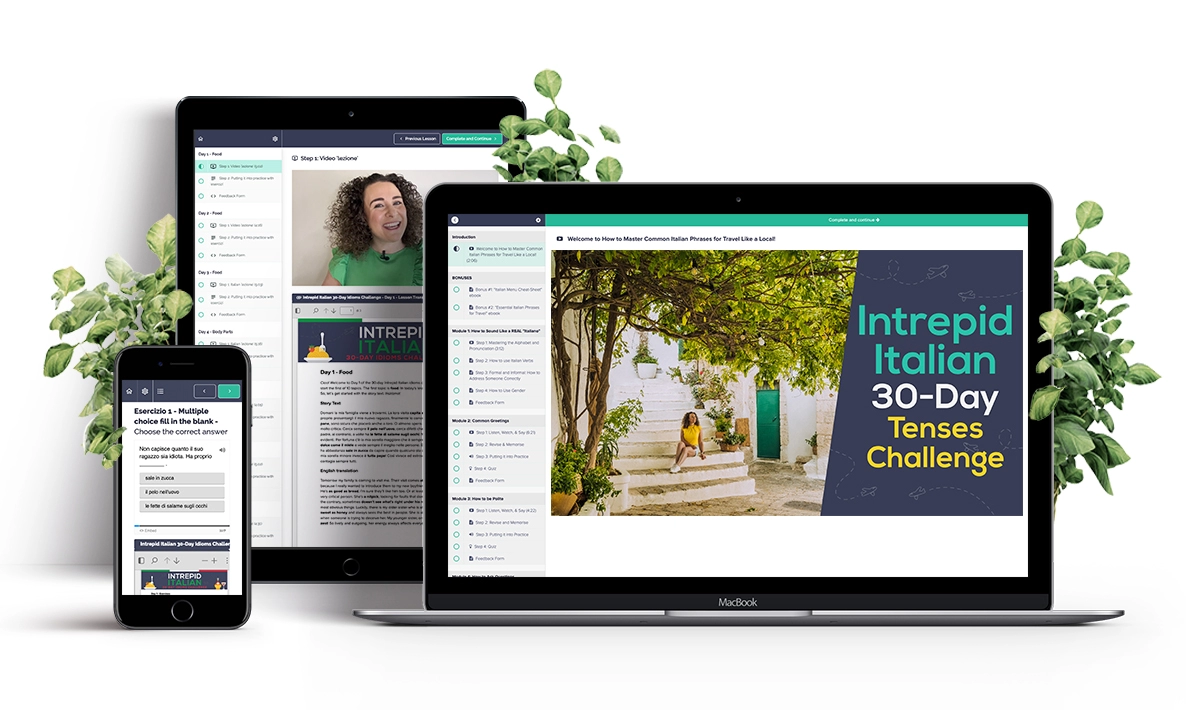 If you found this lesson powerful, then you’ll love Intrepid Italian, my series of online self-paced video courses that break down everything you need to know about Italian using my 80/20 method. Visit IntrepidItalian.com for more details.
If you found this lesson powerful, then you’ll love Intrepid Italian, my series of online self-paced video courses that break down everything you need to know about Italian using my 80/20 method. Visit IntrepidItalian.com for more details.
 Are you a beginner or an intermediate Italian learner? Got a trip coming up or want to communicate with your Italian partner or relatives in Italian? Learn Italian with my unique 80/20 method
Are you a beginner or an intermediate Italian learner? Got a trip coming up or want to communicate with your Italian partner or relatives in Italian? Learn Italian with my unique 80/20 method
Registrations are now open to join Intrepid Italian, my new series of online video courses that use my unique 80/20 method. You’ll go from a shy, confused beginner to a proficient and confident intermediate speaker, with me as your trusty guide.
You’ll finally be able to connect with your Italian partner, speak to your relatives and enjoy authentic travel experiences in Italy that you’ve always dreamed of, and so much more.
As a native English speaker who learned Italian as an adult, I know what it’s like to feel hopeless and lack the confidence to speak. I know what it’s like to start from scratch and to even go back to absolute basics and learn what a verb is!
Intrepid Italian was created with YOU in mind. I use my working knowledge of the English language to help you get into the ‘Italian mindset’ so you can avoid the common pitfalls and errors English speakers make – because I made them once too! I break everything down in such a way that it ‘clicks’ and just makes sense.
No matter what your level is, there is an Intrepid Italian course for you, including:
- 🇮🇹 Intrepid Italian for Beginners (A1)
- 🇮🇹 Intrepid Italian for Advanced Beginners (A2)
- 🇮🇹 Intrepid Italian for Intermediates (B1)
You can join 1, 2, or all 3 courses, it’s entirely up to you. The best part is that you have lifetime access so you learn anytime, anywhere and on any device.
As your guide, I walk you through each lesson, step-by-step, using my unique 80/20 method. My approach is different from traditional methods because I teach you the most important 20% of the language right from the beginning so you can start to speak straight away.
Each course includes video lessons, audio exercises, downloadable worksheets, bonus guides, a private support community, and lifetime access all designed to streamline your learning while having fun.
It even comes with my famous “Celebrate with a Spritz Guarantee”. After 30 days of using Intrepid Italian, if you don’t want to celebrate your new-found Italian skills with an Aperol Spritz, you don’t have to pay a penny! Cheers! 🥂
Join Intrepid Italian here and start learning today!
Ci vediamo lì! (See you there!)
Learning Italian? Check out these Italian language guides
- Italian for Beginners | How to Learn Italian in 3 Simple Steps
- TOP 100 Most Common Italian Words (Plus PDF Cheat-Sheet & Quiz)
- Italian Prepositions:The Only Guide You’ll Ever Need (PLUS Chart)
- 17 Weird Italian Superstitions Italians ACTUALLY Live By
- 17 Must-Know Italian Hand Gestures: The Ultimate Guide
- 10 Ways Natives REALLY Say ‘You’re Welcome’ in Italian
- How to say ‘Please’ in Italian in 9 Ways Like a Native
- 41 Italian Greetings: How to Say ‘Hello’ in Italian Like a Local
- 125 Most Common Italian Phrases for Travel You’ll Ever Need [PLUS Printable]
- 8 DEADLY mistakes in Italian (& How to Avoid Them)
- How to Conjugate Italian Verbs in 3 Simple Steps [Italian for Beginners]
- Is Italian Hard to Learn? 7 Common Mistakes & How to Avoid Them
- Master Days of the Week in Italian (7 Simple Memory Hacks)
- Italian Numbers: How to Count in Italian From 0 to 1 Billion (Plus PDF Download)
- How to Order Food & Drinks in Italian [Italian for Beginners]
- 15 Italian Words You Should NEVER Mispronounce [& How Not To]
- 11 Effective Hacks That’ll Help You Learn Italian So Much Faster
- Top 14 Italian Words You Should NEVER Say [& What to Use Instead]
- 20 Hilarious Everyday Italian Expressions You Should Use
- Romanesco: 25 Cool Roman Dialect Words You Should Use in Rome
- 10 Reasons Why Learning Italian Will Change Your Life
- 10 Italian Expressions Italians Love Saying
- 10 Italian Phrases That Will Instantly Make You Sound more Italian
- Funny Italian Sayings: 26 Food-Related Insults You Won’t Forget
- 15 Romantic Italian Films That’ll Make You Love Italy Even More
- How to Master Common Italian Phrases for Travel (Like a Local!)
Like it? Pin it for later!

Over to you!
Did you enjoy this lesson? Do you have a question? Let me know using the comments section below or join me on social media @intrepidguide or @intrepiditalian to start a conversation.
Thanks for reading and I hope you enjoyed this post.
Like what you see? Subscribe using the form below to have all of my posts delivered directly to your email.


